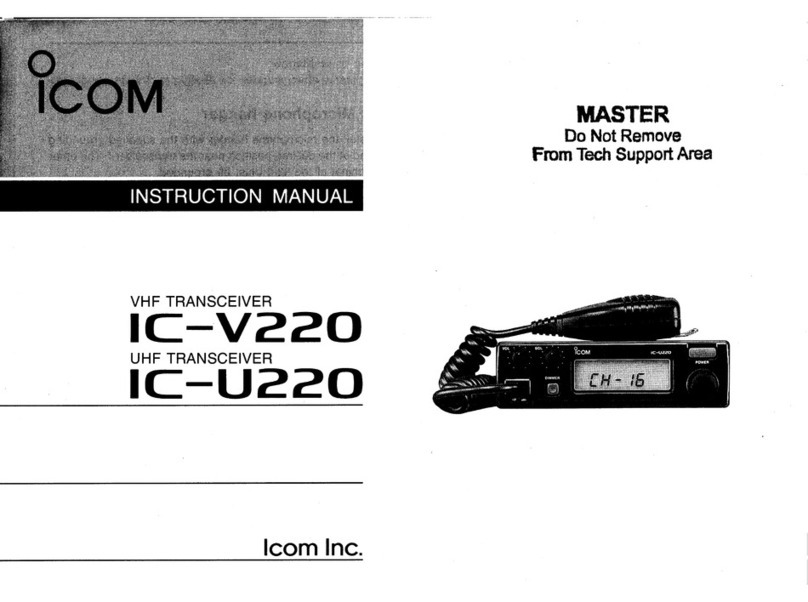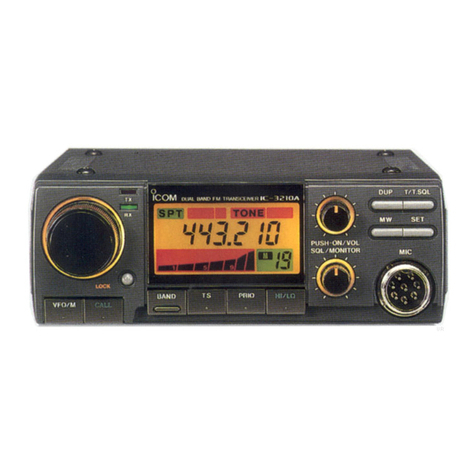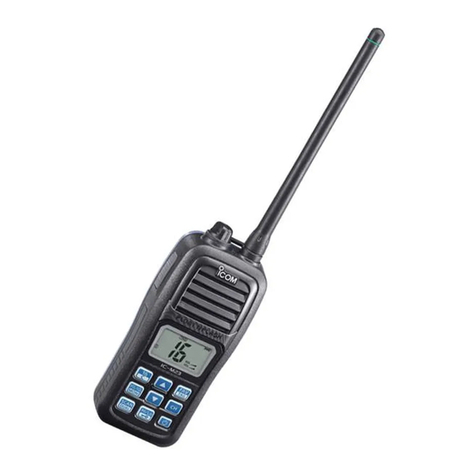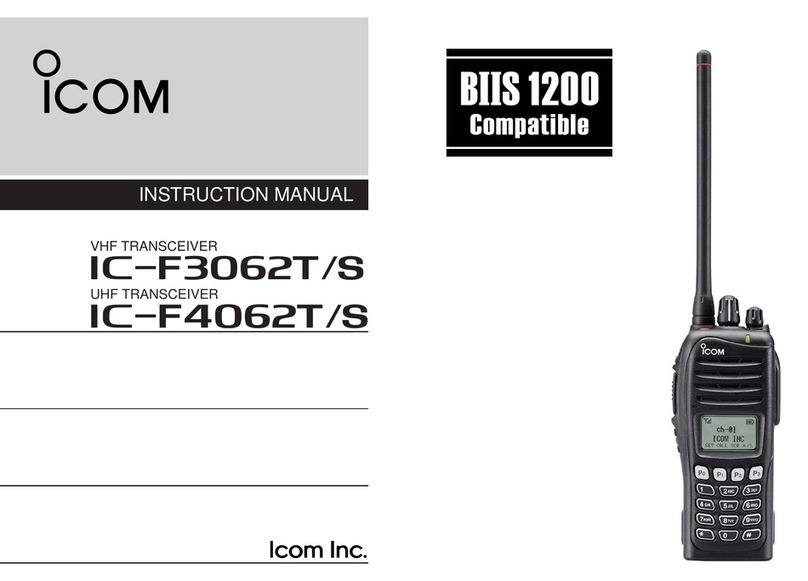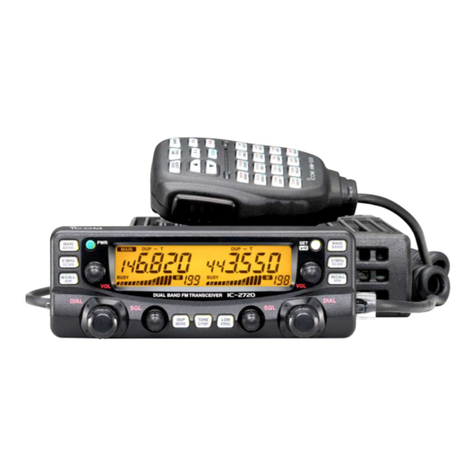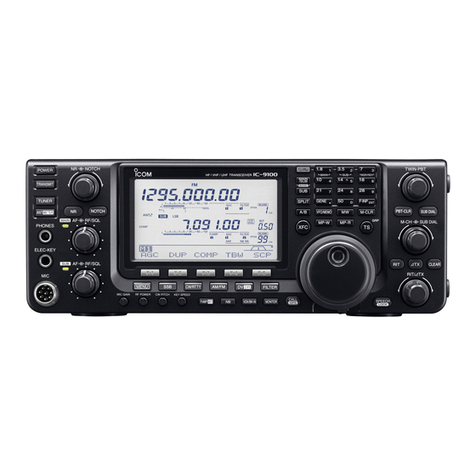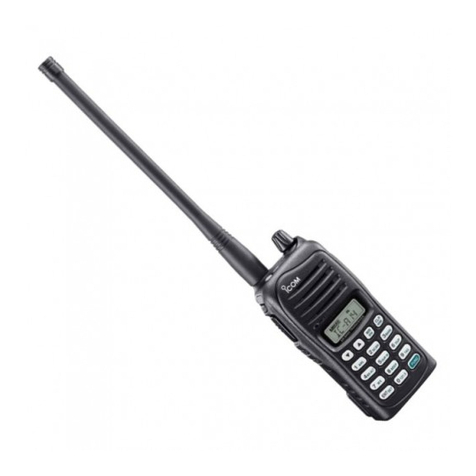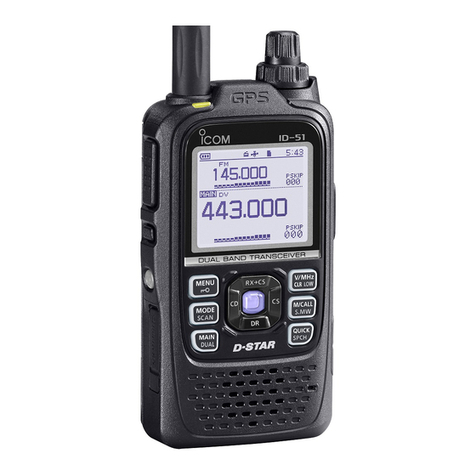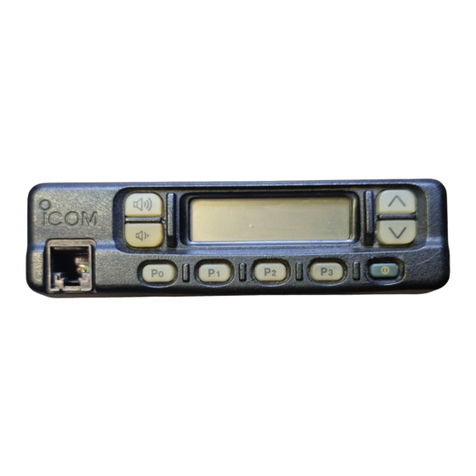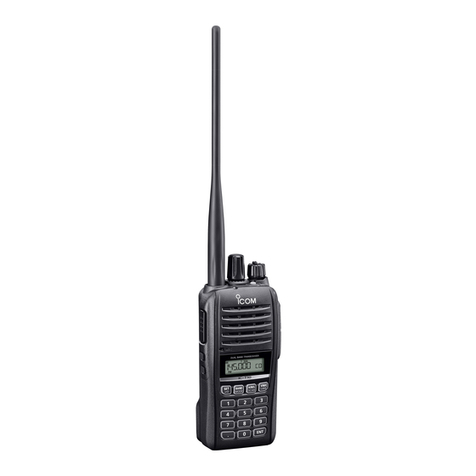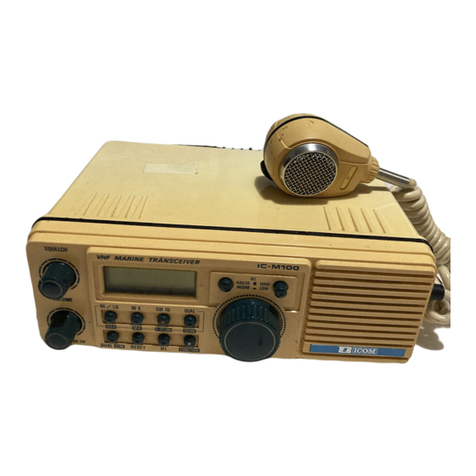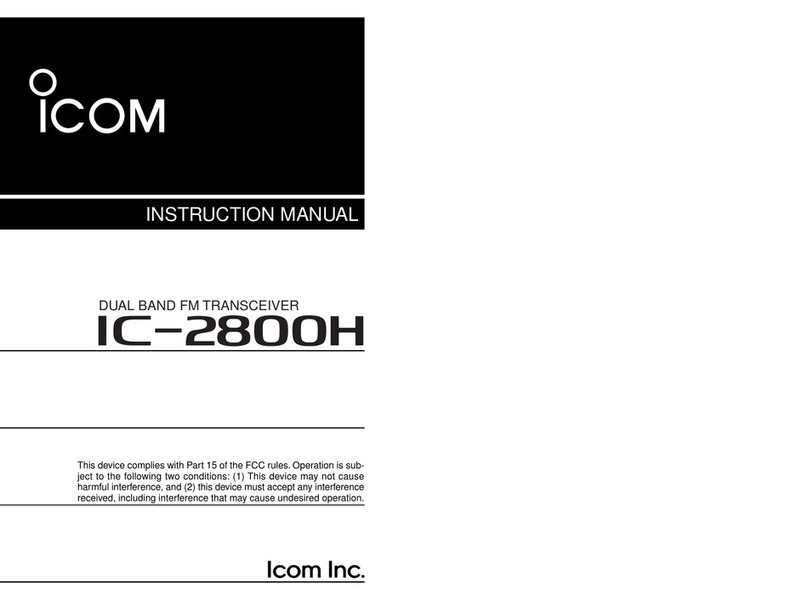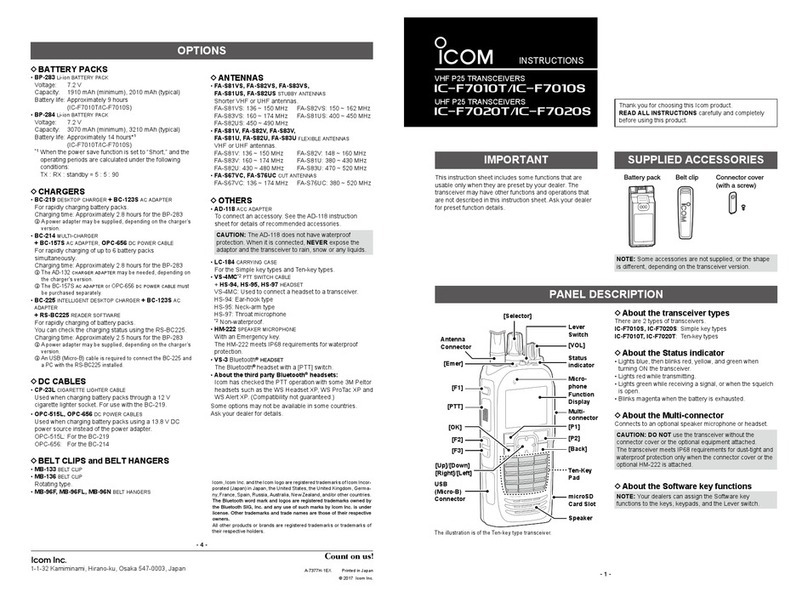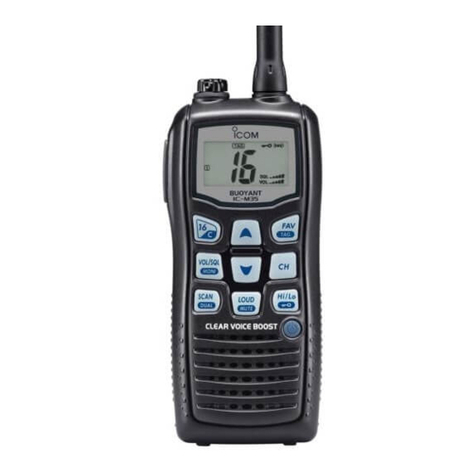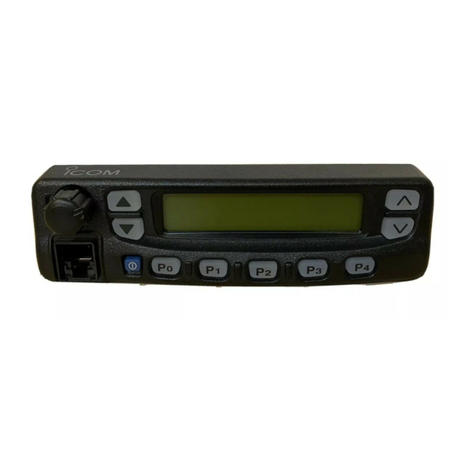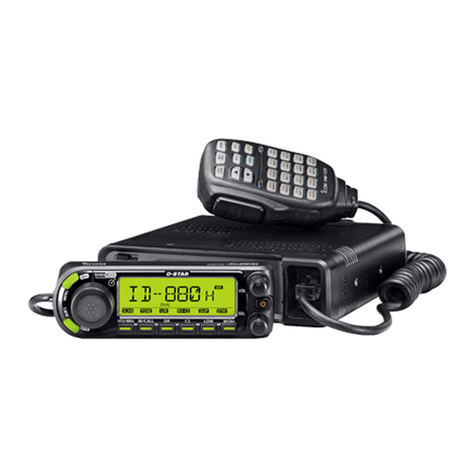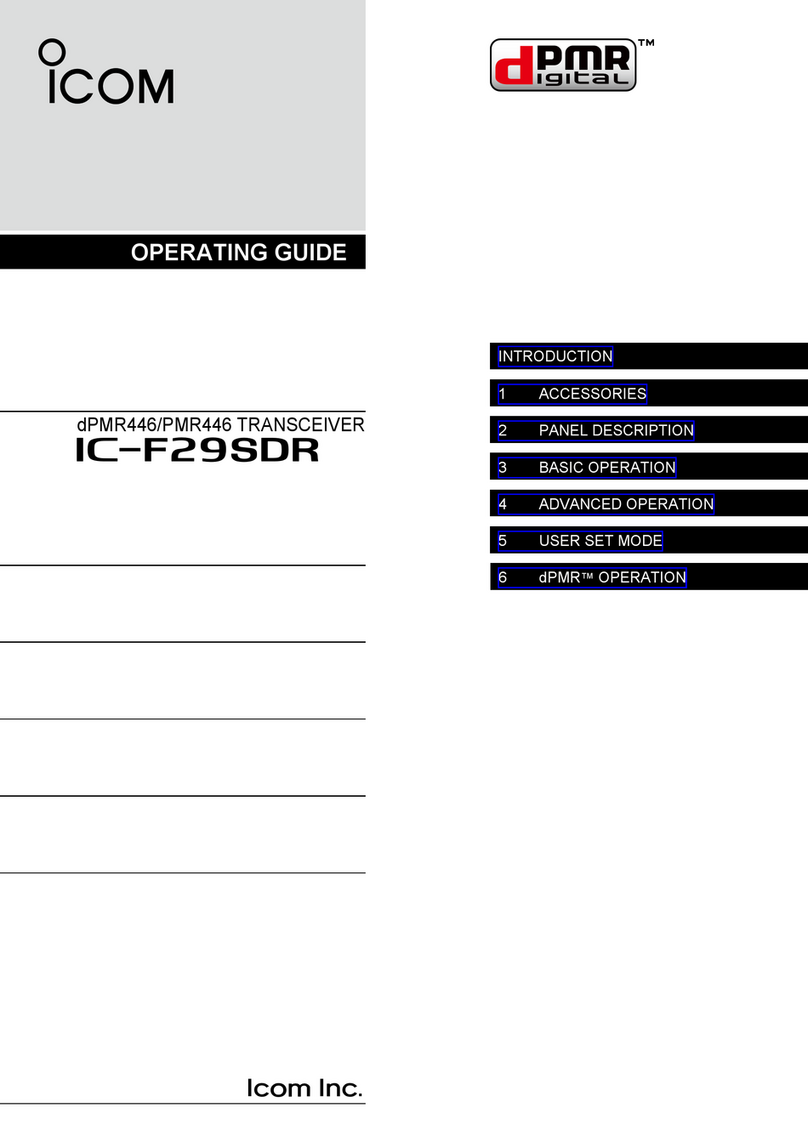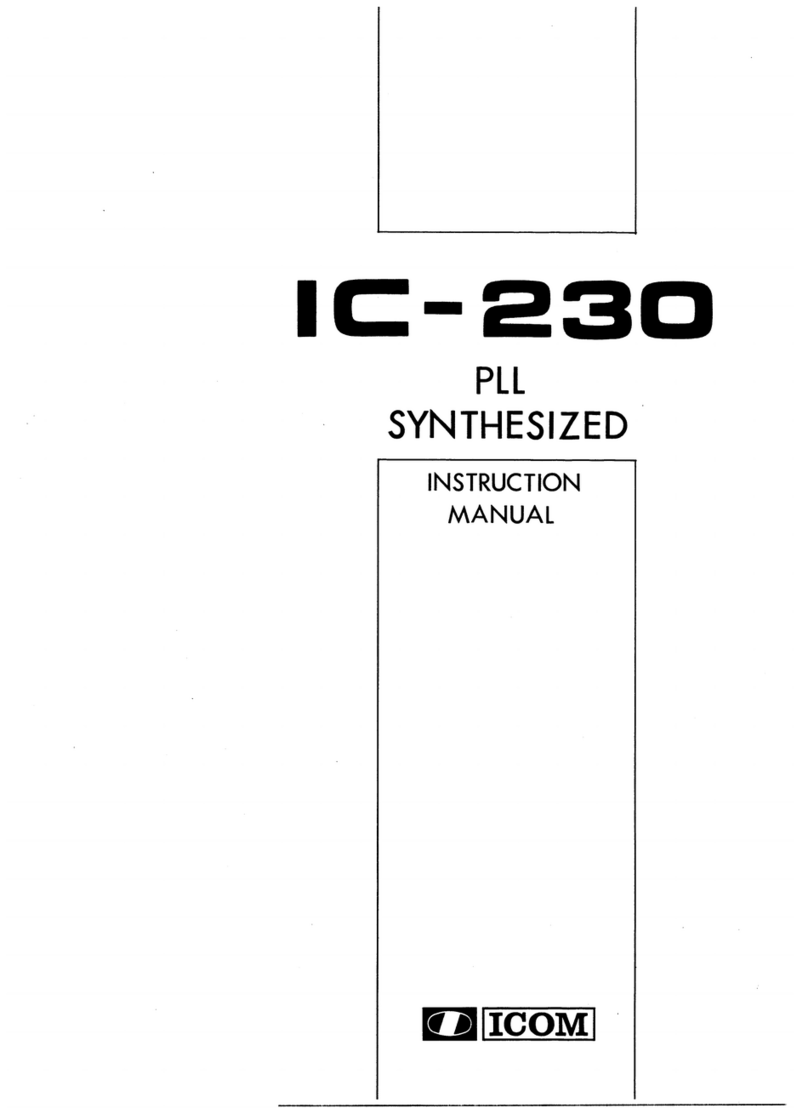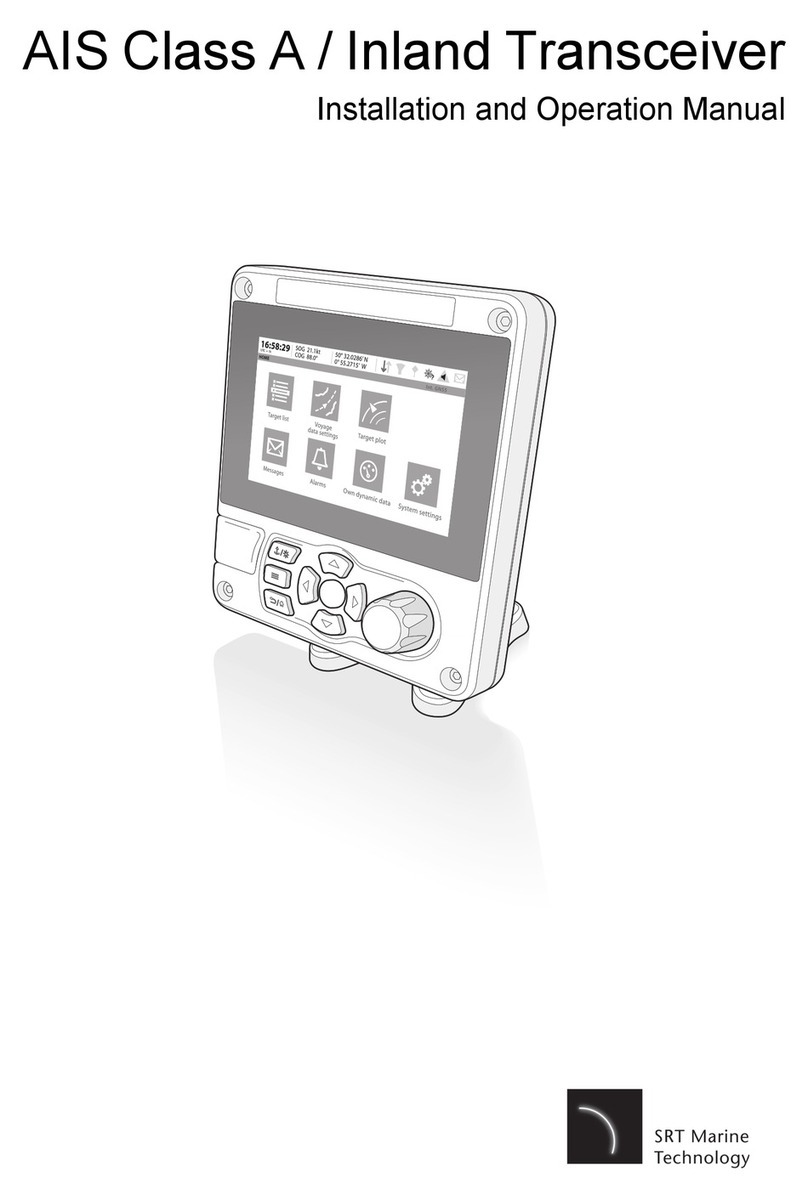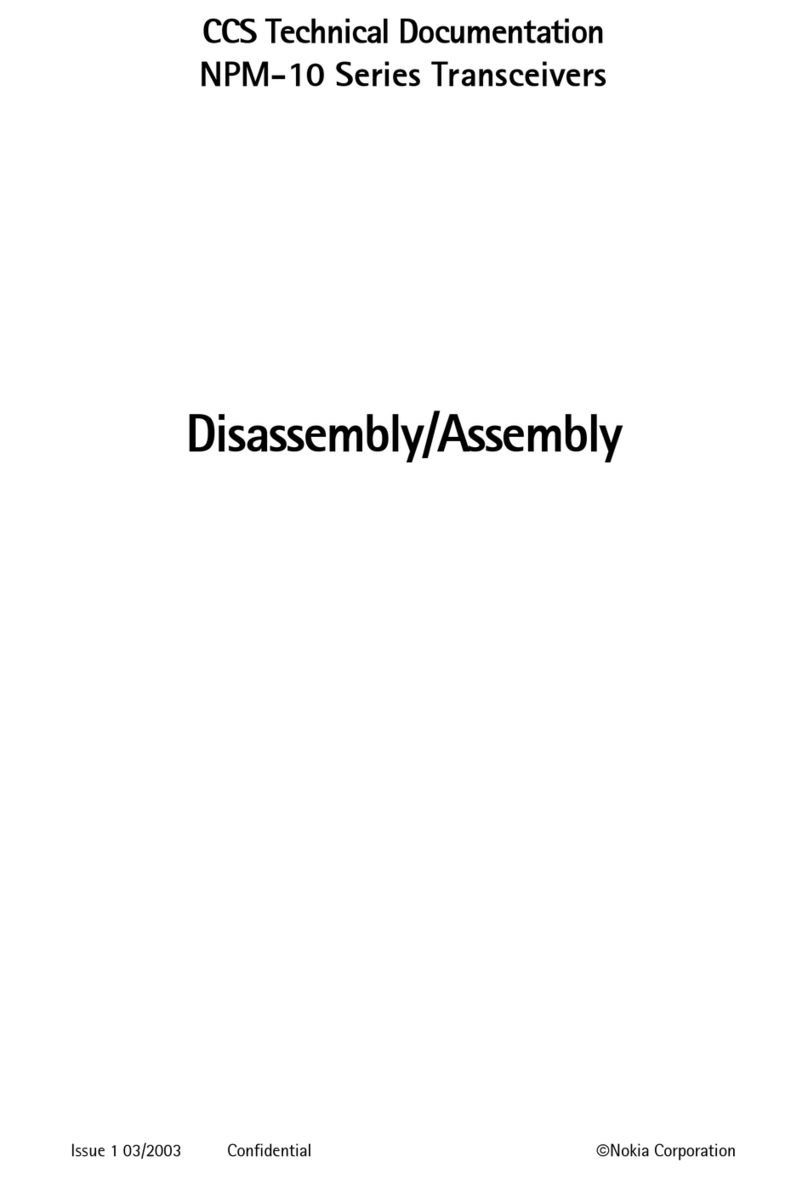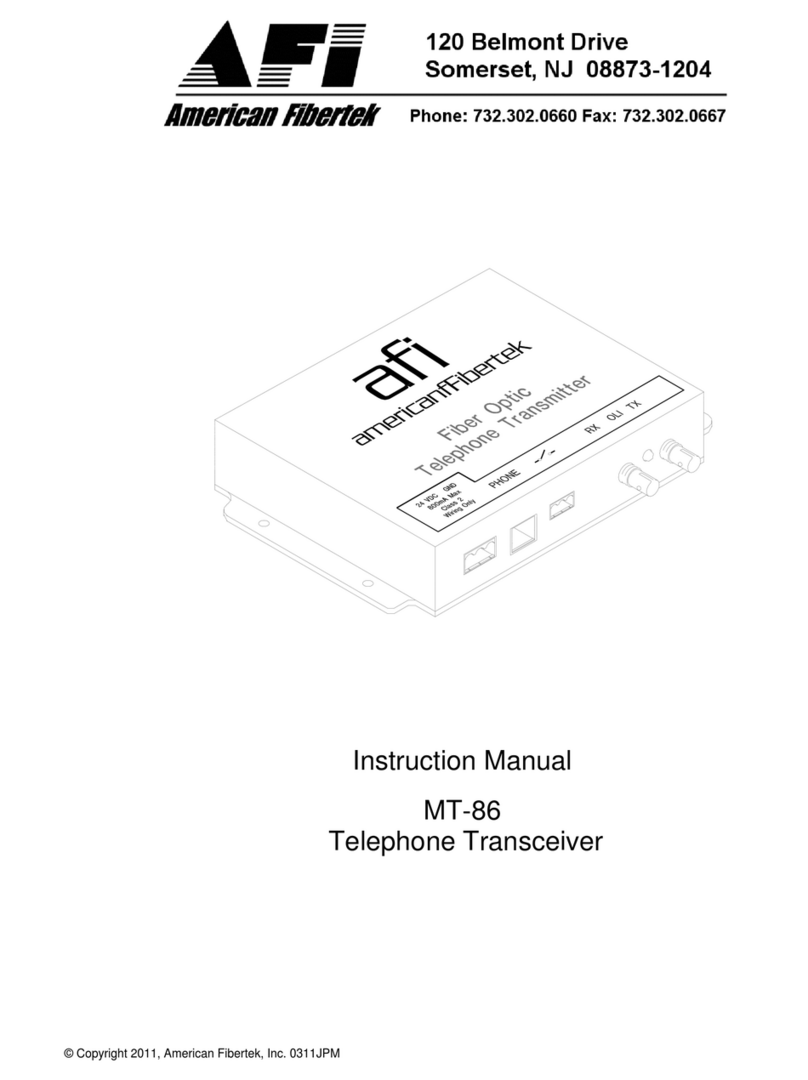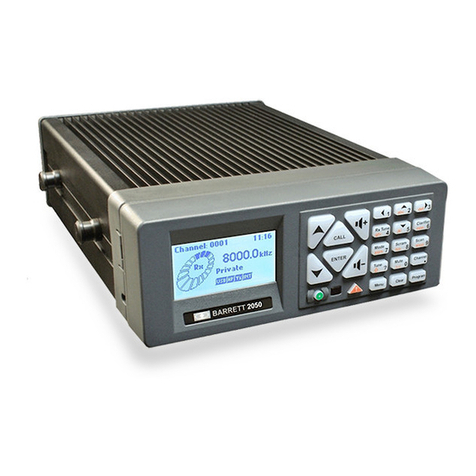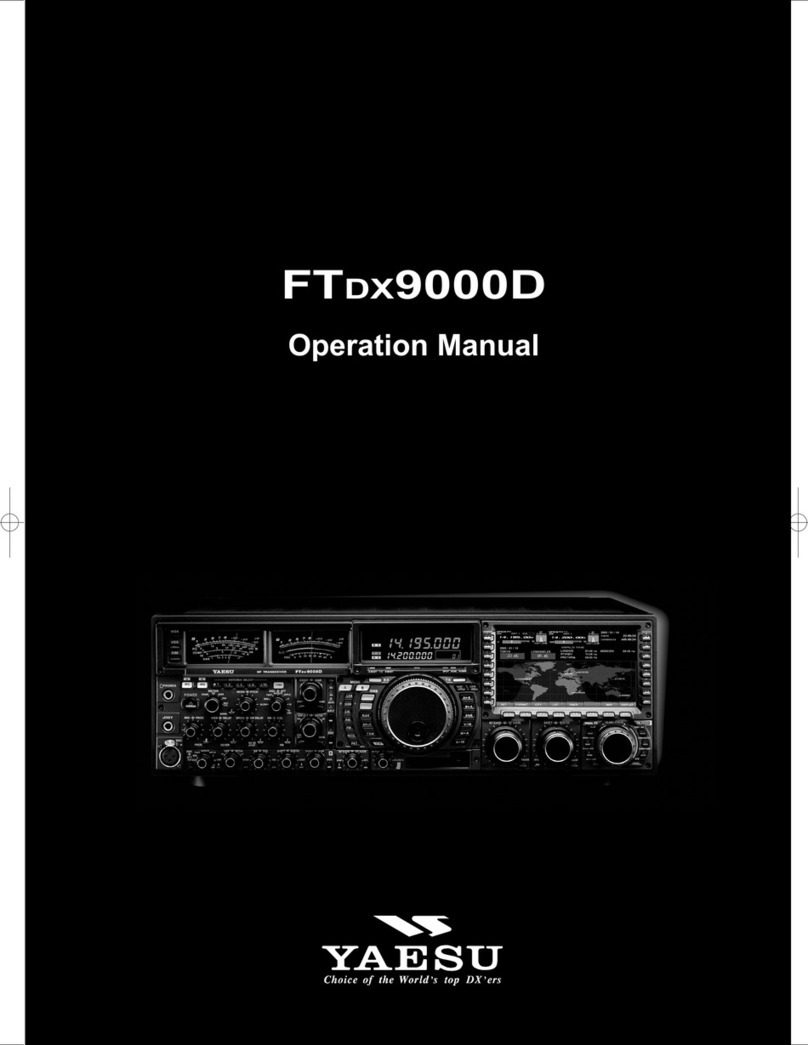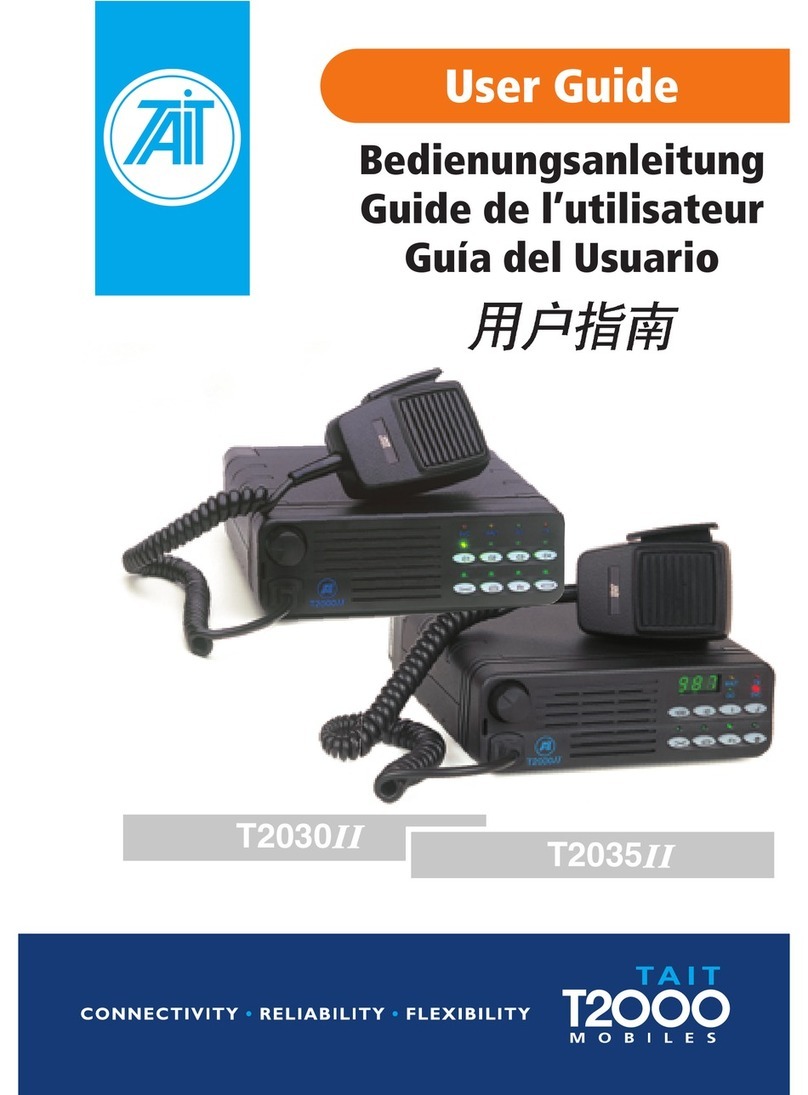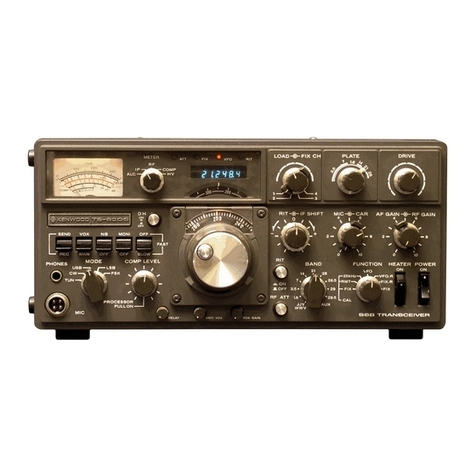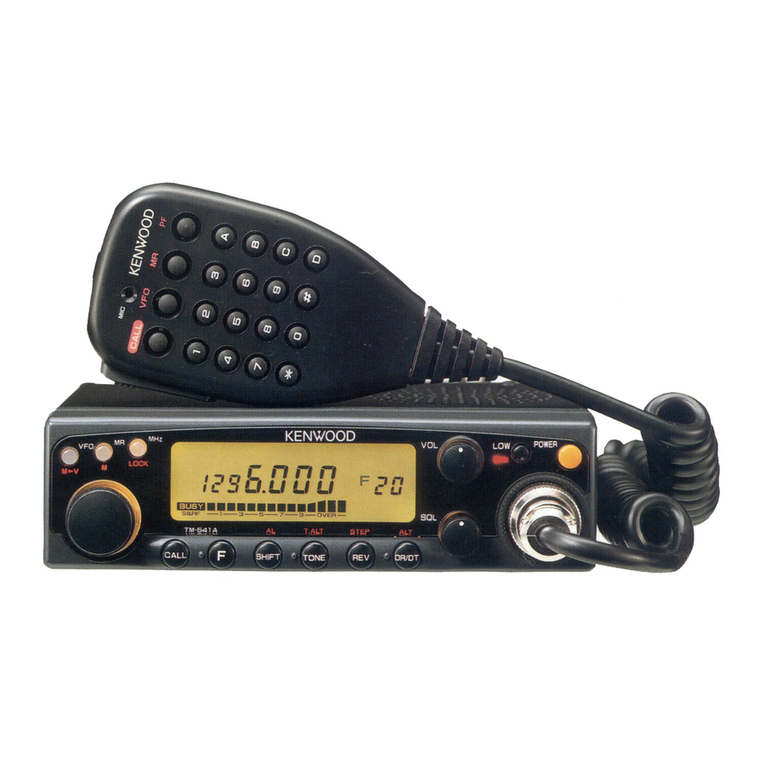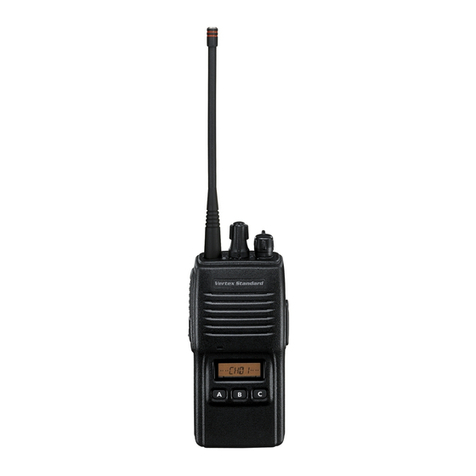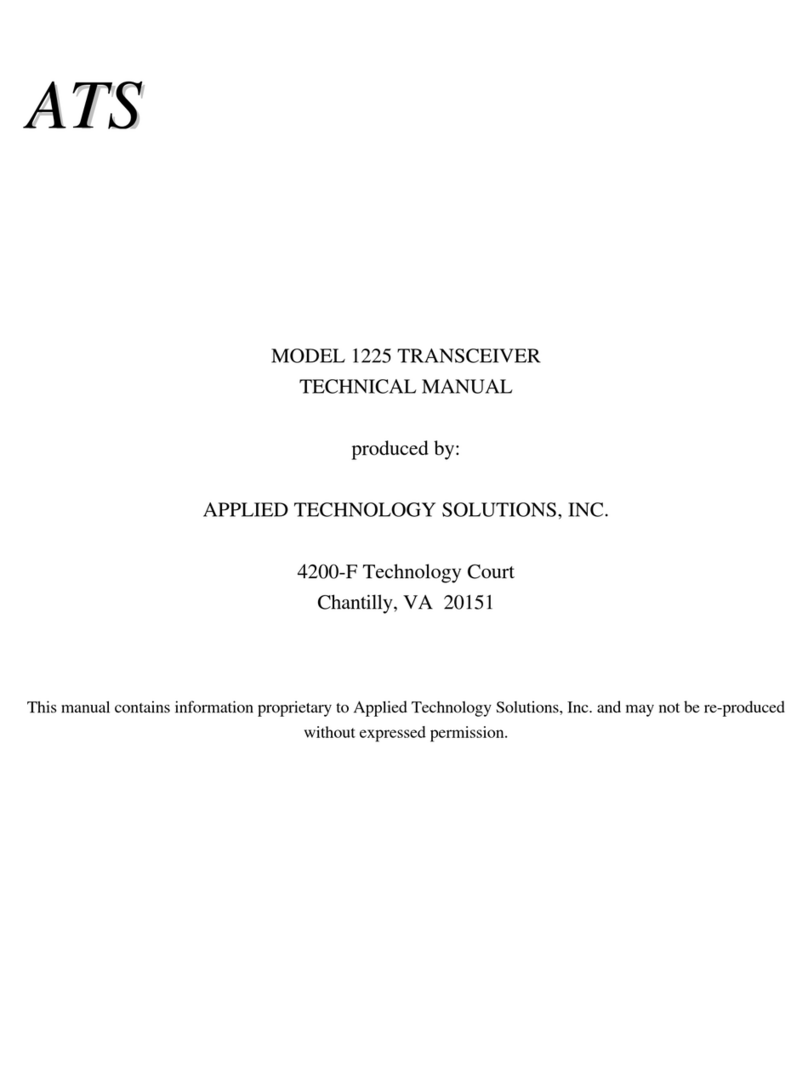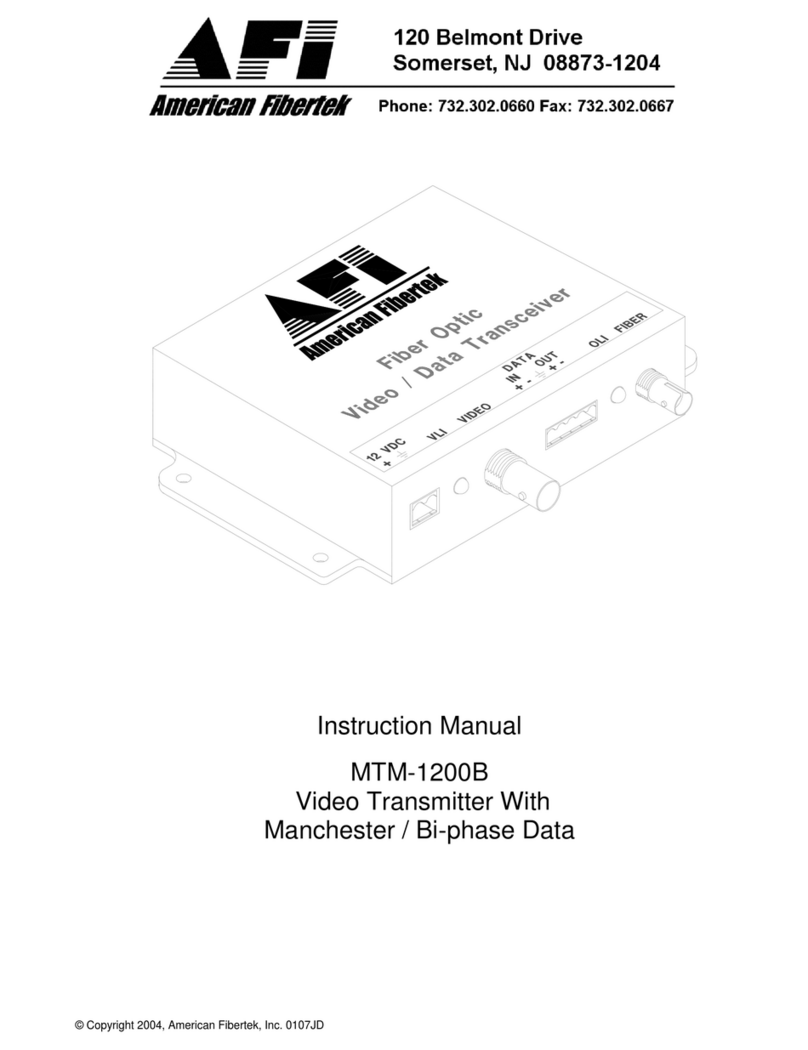Icom IC-F3GT User manual

SERVICE
MANUAL
1-1-32, Kamiminami, Hirano-ku, Osaka, 547-0003, Japan S-13713IZ-C1V-q
© 2000 Icom Inc.
VHF FM TRANSCEIVERS

Communication Equipment
Himmelgeister Str. 100, D-40225 Düsseldorf, Germany
Phone: 0211 346047 Fax : 0211 333639
URL : http://www.icomeurope.com
Unit 9, Sea St., Herne Bay, Kent, CT6 8LD, U.K.
Phone: 01227 741741 Fax : 01227 741742
URL : http://www.icomuk.co.uk
Zac de la Plaine, Rue Brindejonc des Moulinais
BP 5804, 31505 Toulouse Cedex, France
Phone: 561 36 03 03 Fax : 561 36 03 00
URL : http://www.icom-france.com
Crta. de Gracia a Manresa Km.14,750
08190 Sant Cugat del Valles Barcelona, SPAIN
Phone : (93)590 26 70 Fax : (93)589 04 46
URL : http://www.icomspain.com
<
Corporate Headquarters
>
2380 116th Avenue N.E., Bellevue,WA 98004, U.S.A.
Phone : (425)454-8155 Fax : (425)454-1509
URL : http://www.icomamerica.com
<
Customer Service
>
Phone : (425)454-7619
Glenwood Centre #150-6165
Highway 17 Delta, B.C., V4K 5B8, Canada
Phone : (604)952-4266 Fax : (604)952-0090
URL : http://www.icomcanada.com
A.B.N.88 006 092 575
290-294 Albert Street, Brunswick, Victoria, 3056, Australia
Phone: 03 9387 0666 Fax : 03 9387 0022
URL : http://www.icom.net.au
146A Harris Road, East Tamaki,
Auckland, New Zealand
Phone: 09 274 4062 Fax : 09 274 4708
URL : http://www.icom.co.nz 6F No.68, Sec.1 Cheng-Teh Road, Taipei, Taiwan, R.O.C.
Phone: (02) 2559 1899 Fax : (02) 2559 1874
1-1-32, Kamiminami, Hirano-ku, Osaka 547-0003, Japan
Phone : 06 6793 5302
Fax : 06 6793 0013
URL : http://www.icom.co.jp/world/index.html
Icom America Inc. Icom (Europe) GmbH
Asia Icom Inc.
Icom Spain S.L
Icom (UK) Ltd.
Icom France S.a
Icom Canada
Icom (Australia) Pty. Ltd.
Icom New Zealand
INTRODUCTION
DANGER
ORDERING PARTS
REPAIR NOTES
This service manual describes the latest service information
for the IC-F3GT and IC-F3GS at the time of publication.
NEVER connect the transceiver to an AC outlet or to a DC
power supply that uses more than 16 V. Such a connection
could cause a fire hazard and/or electric shock.
DO NOT expose the transceiver to rain, snow or any liquids.
DO NOT reverse the polarities of the power supply when con-
necting the transceiver.
DO NOT apply an RF signal of more than 20 dBm (100mW)
to the antenna connector. This could damage the transceiv-
er’s front end.
Be sure to include the following four points when ordering
replacement parts:
1. 10-digit order numbers
2. Component part number and name
3. Equipment model name and unit name
4. Quantity required
<SAMPLE ORDER>
1130007610 S.IC µPD3140GS IC-F3GT MAIN UNIT 1 pieces
8810009510 Screw BT M2 x 4 NI-ZU IC-F3GS Chassis 10 pieces
Addresses are provided on the inside back cover for your
convenience.
1. Make sure a problem is internal before disassembling the transceiver.
2. DO NOT open the transceiver until the transceiver is disconnected from its power source.
3. DO NOT force any of the variable components. Turn them slowly and smoothly.
4. DO NOT short any circuits or electronic parts. An insulated turning tool MUST be used for all adjustments.
5. DO NOT keep power ON for a long time when the transceiver is defective.
6. DO NOT transmit power into a signal generator or a sweep generator.
7. ALWAYS connect a 40 dB to 50 dB attenuator between the transceiver and a deviation meter or spectrum analyzer when
using such test equipment.
8. READ the instructions of test equipment thoroughly before connecting equipment to the transceiver.
To upgrade quality, all electrical or mechanical parts and
internal circuits are subject to change without notice or oblig-
ation.
IC-F3GT IC-F3GS

TABLE OF CONTENTS
SECTION 1 SPECIFICATIONS
SECTION 2 INSIDE VIEWS
SECTION 3 DISASSEMBLY AND OPTION INSTRUCTIONS
3-1 DISASSEMBLY INSTRUCTION . . . . . . . . . . . . . . . . . . . . . . . . . . . . . . . . . . . . . . . . . . . . . .3-1
3-2 OPTIONAL UNIT INSTALLATIONS . . . . . . . . . . . . . . . . . . . . . . . . . . . . . . . . . . . . . . . . . . . .3-2
SECTION 4 CIRCUIT DESCRIPTION
4-1 RECEIVER CIRCUITS . . . . . . . . . . . . . . . . . . . . . . . . . . . . . . . . . . . . . . . . . . . . . . . . . . . . .4-1
4-2 TRANSMITTER CIRCUITS . . . . . . . . . . . . . . . . . . . . . . . . . . . . . . . . . . . . . . . . . . . . . . . . .4-1
4-3 PLL CIRCUITS . . . . . . . . . . . . . . . . . . . . . . . . . . . . . . . . . . . . . . . . . . . . . . . . . . . . . . . . . . .4-2
4-4 POWER SUPPLY CIRCUITS . . . . . . . . . . . . . . . . . . . . . . . . . . . . . . . . . . . . . . . . . . . . . . . .4-3
4-5 CPU PORT CIRCUITS . . . . . . . . . . . . . . . . . . . . . . . . . . . . . . . . . . . . . . . . . . . . . . . . . . . . .4-4
SECTION 5 ADJUSTMENT PROCEDURES
5-1 PREPARATION . . . . . . . . . . . . . . . . . . . . . . . . . . . . . . . . . . . . . . . . . . . . . . . . . . . . . . . . . .5-1
5-2 PLL ADJUSTMENT . . . . . . . . . . . . . . . . . . . . . . . . . . . . . . . . . . . . . . . . . . . . . . . . . . . . . . .5-3
5-3 TRIMMER ADJUSTMENT . . . . . . . . . . . . . . . . . . . . . . . . . . . . . . . . . . . . . . . . . . . . . . . . . .5-4
5-4 TRANSMITTER ADJUSTMENT . . . . . . . . . . . . . . . . . . . . . . . . . . . . . . . . . . . . . . . . . . . . . .5-6
5-5 RECEIVER ADJUSTMENT . . . . . . . . . . . . . . . . . . . . . . . . . . . . . . . . . . . . . . . . . . . . . . . . . .5-6
SECTION 6 PARTS LIST
SECTION 7 MECHANICAL PARTS AND DISASSEMBLY
SECTION 8 SEMI-CONDUCTOR INFORMATION
SECTION 9 BOARD LAYOUTS
9-1 GENERAL AND EIA/TIA VERSIONS (EXCEPT W/N-TYPE) . . . . . . . . . . . . . . . . . . . . . . . . .9-1
9-2 ETS/CEPT VERSION . . . . . . . . . . . . . . . . . . . . . . . . . . . . . . . . . . . . . . . . . . . . . . . . . . . . . .9-3
9-3 W/N-TYPE . . . . . . . . . . . . . . . . . . . . . . . . . . . . . . . . . . . . . . . . . . . . . . . . . . . . . . . . . . . . . .9-5
SECTION 10 BC-137 OPTIONAL DESKTOP CHARGER INFORMATION
10-1 PARTS LIST . . . . . . . . . . . . . . . . . . . . . . . . . . . . . . . . . . . . . . . . . . . . . . . . . . . . . . . . . . . . .10-1
10-2 DISASSEMBLY INFORMATION . . . . . . . . . . . . . . . . . . . . . . . . . . . . . . . . . . . . . . . . . . . . . .10-1
10-3 VOLTAGE DIAGRAM . . . . . . . . . . . . . . . . . . . . . . . . . . . . . . . . . . . . . . . . . . . . . . . . . . . . . .10-2
10-4 BOARD LAYOUT . . . . . . . . . . . . . . . . . . . . . . . . . . . . . . . . . . . . . . . . . . . . . . . . . . . . . . . . .10-2
SECTION 11 BLOCK DIAGRAM
SECTION 12 VOLTAGE DIAGRAM

1 - 1
SECTION 1 SPECIFICATIONS
All stated specifications are subject to change without notice or obligation.
Frequency coverage
Type of emission
Number of channels
Power supply requirement
TX at High
Current drain at Low
(approx.) RX rated audio
stand-by
Frequency stability
Usable temperature range
Dimensions (proj. not included)
Weight (with BP-209)
Output power
Modulation system
Max. freqequency deviation
Spurious emissions
Adjacent channel power
Transmitter audio distortion
Limitting charact of modulator
Ext. microphone connector
Receive system
Intermediate frequencies
Sensitivity (typical)
Squelch sencitivity
Adjacent channel selectivity
Spurious response
Intermoduration rejection ratio
Hum and noise
Audio output power
(at 7.2 V DC)
External SP connector
ETS 300 086 EIA/TIA 603
RECEIVER TRANSMITTER GENERAL
136.000–150.000 MHz (L-band), 146.000–174.000 MHz (H-band)
16K0F3E (W-type), 14K0F3E (M-type), 8K50F3E (N-type)
100 ch (100 channel version),
32 ch (16 channels ×2 banks: 2-BANK version), 16 ch (16 channel version)
7.2 V DC (negative ground; supplied battery pack)
1.6 A
700 mA
250 mA
70 mA
±2000 Hz (W/M-type), ±1.5 kHz (N-type) ±0.0005%
–25˚C to +55˚C –30˚C to +60˚C
54(W) ×132(H) ×35(D) mm; 21⁄8(W) ×57⁄32(H) ×13⁄8(D) inch
370 g; 13.1 oz
High 5 W
Low 1 W
Variable reactance frequency modulation
±5.0 kHz (W-type), ±4.0 kHz (M-type)*1, ±2.5 kHz (N-type)
0.25 µW @ < 1 GHz, 1.00 µW @ > 1 GHz 73 dBc typical
70 dB (W/M-type) 70 dB typical (W-type)
60 dB (N-type) 60 dB typical (N-type)
Less than 5% at 1 kHz, 60% deviation Less than 3% at 1 kHz, 40% deviation
70–100% of max. deviation
3-conductor 2.5(d) mm (1⁄10")/2.2 kΩ
Double-conversion superheterodyne system
1st: 31.05 MHz, 2nd: 450 kHz
0.25 µV at 12 dB SINAD 0.25 µV at 12 dB SINAD
0.63 µV (emf) at 20 dB SINAD
0.25 µV typical (at threshold)
70 dB (W/M-type) 75 dB typical (W-type)
60 dB (N-type) 65 dB typical (N-type)
70 dB 70 dB typical
65 dB 70 dB typical
45 dB typical (W/M-type) 45 dB typical (W-type)
43 dB typical (N-type) 40 dB typical (N-type)
500 mW typical at 5% distortion with an 8 Ωload
3-conductor 3.5(d) mm (1⁄8")/8 Ω
Measurements made in accordance with EIA/TIA-152-C, 204-D, 603 or ETS 300-086.

2 - 1
SECTION 2 INSIDE VIEWS
• MAIN UNIT
Power amplifier
(Q1: 2SK2974)
Antenna swtching circuit
(D1, D2, D8: MA77)
TOP VIEW BOTTOMVIEW
RF amplifier
(Q12: 3SK293)
VCO circuit
1st mixer
Q13: 3SK239A [OTHER]
3SK320 B
Low-pass filter circuit
TX/RX switch
(D3, D4: MA77)
Mic amplifier circuit
APC
IC3A: NJM2902V
Q37: DTA144EU
FM IF IC
(IC2: TA31136FN(D))
CPU
(IC8: HD6433876B50H)
EEPROM
IC7: HN58X2432TI [OTHER]
HN58X2464TI H
D/A converter
(IC10: M62363FP-650C)
PLL reference oscillator
X1: CR-664A15.3 MHz [OTHER]
CR-671A 15.3 MHz A, D
Crystal filter
FI1: FL-311 [OTHER]
FL-312 C
FL-333 F, G
FL-334 E
PLL IC
(IC1: µPD3140GS)
IF amplifier
(Q14: 2SC4215 O)
()
()
()
()
()
A: W/N-type B: ETS/CEPT version
C: W-type of [GEN] D: EIA/TIA version
E: W-type of ETS/CEPT version F: N-type of ETS/CEPT version
G: M (20 kHz)-type H: 100 channel version

3 - 1
SECTION 3 DISASSEMBLY AND OPTION INSTRUCTIONS
3-1 DISASSEMBLY INSTRUCTION
• REMOVING THE CHASSIS PANEL
1Unscrew 1 nut A, and remove 1 knob B.
2Unscrew 2 screws C.
3Take off the chassis in the direction of the arrow.
4Unplug J6 to separate front panel and chassis.
• REMOVING THE MAIN UNIT
1Remove the searing rubber.
2Unsolder 4 points D, and unscrew 1 nut E.
3Unscrew 3 screws Fand 6 screws G (silver, 2 mm) to separate the chassis and the MAIN unit.
4Take off the MAIN unit in the direction of the arrow.
(nickel, 2 mm) x 2
Front panel
Chassis
J6 (Speaker connector)
B
C
A
F(black, 2 mm) x 2
(silver, 2 mm) x 6
Shield cover
Guide holes
MAIN unit
Sealing rubber Chassis
FDDG
D
E
G
G

3 - 2
3-2 OPTIONAL UNIT INSTALLATIONS
1Remove the option cover.
2Connect one of UT-96, UT-105, UT-108, UT-109, UT-110, and UT-111 optional unit to J5.
3Replace the option cover to the chassis-hole.
Option cover
Option unit
J5

4 - 2
SECTION 4 CIRCUIT DESCRIPTION
4-1 RECEIVER CIRCUITS
4-1-1 ANTENNA SWITCHING CIRCUIT
Received signals are passed through the low-pass filter (L1,
L2, C1–C5, C8). The filtered signals are applied to the λ⁄4
type antenna switching circuit (D2, D8).
The antenna switching circuit functions as a low-pass filter
while receiving. However, its impedance becomes very high
while D2 and D8 are turned ON. Thus transmit signals are
blocked from entering the receiver circuits. The antenna
switching circuit employs a λ⁄4type diode switching system.
The passed signals are then applied to the RF amplifier cir-
cuit.
4-1-2 RF CIRCUIT
The RF circuit amplifies signals within the range of frequen-
cy coverage and filters out-of-band signals.
The signals from the antenna switching circuit are amplified
at the RF amplifier (Q12) after passing through the tunable
bandpass filter (D9, D10, L16, L17, C78–C80, C83, C86,
C277). The amplified signals are applied to the 1st mixer cir-
cuit (Q13) after out-of-band signals are suppressed at the
tunable bandpass filter (D11, D12, L18, L19, C91, C92, C94,
C96–C98).
Varactor diodes are employed at the bandpass filters that
track the filters and are controlled by the CPU (IC8) via the
expander IC (IC10) using T1–T4 signals. These diodes tune
the center frequency of an RF passband for wide bandwidth
receiving and good image response rejection.
4-1-3 1ST MIXER AND 1ST IF CIRCUITS
The 1st mixer circuit converts the received signal into a fixed
frequency of the 1st IF signal with a PLL output frequency.
By changing the PLL frequency, only the desired frequency
will pass through a crystal filter at the next stage of the 1st
mixer.
The signals from the RF circuit are mixed at the 1st mixer
(Q13) with a 1st LO signal coming from the VCO circuit to
produce a 31.05 MHz 1st IF signal.
The 1st IF signal is applied to two crystal filters (FI1) to sup-
press out-of-band signals. The filtered 1st IF signal is
applied to the IF amplifier (Q14), then applied to the 2nd
mixer circuit (IC2, pin 16).
4-1-4 2ND IF AND DEMODULATOR CIRCUITS
The 2nd mixer circuit converts the 1st IF signal into a 2nd IF
signal. A double conversion superheterodyne system (which
converts receive signals twice) improves the image rejection
ratio and obtains stable receiver gain.
The 1st IF signal from the IF amplifier is applied to the 2nd
mixer section of the FM IF IC (IC2, pin 16), and is mixed with
the 2nd LO signal to be converted into a 450 kHz 2nd IF sig-
nal.
The FM IF IC contains the 2nd mixer, limiter amplifier, quad-
rature detector and active filter circuits. A 2nd LO signal
(30.6 MHz) is produced at the PLL circuit by doubling it’s ref-
erence frequency.
The 2nd IF signal from the 2nd mixer (IC2, pin 3) passes
through a ceramic filter (FI2) to remove unwanted hetero-
dyned frequencies. It is then amplified at the limiter amplifi-
er (IC2, pin 5) and applied to the quadrature detector (IC2,
pins 10, 11) to demodulate the 2nd IF signal into AF signals.
• 2nd IF and demodulator circuits
Mixer
16
Limiter
amp.
2nd IF filter
450 kHz PLL IC
IC1
X1
15.3 MHz
IC2 TA31136F
12 1st IF from the IF amplifier (Q14)
"SD" signal to the CPU pin 98
11109
87 5 3
AF signal "DET"
R5
X3
R86
C122 C121
R88R87
R83
"SQLIN" signal from the
D/A convertor (IC10, pin 23)
R82
C112 C113
C116
2
17 16
Active
filter
FI2
Noise
detector
FM
detector
13
"NOIS" signal to the CPU pin 19
RSSI
Noise
comp.
×2
R84

4 - 3
4-1-5 AF CIRCUIT
AF signals from the FM IF IC (IC2, pin 9) are applied to the
mute switch (IC4, pin 1) via the AF filter circuit (IC3b, pins 6,
7). The output signals from pin 11 are applied to the AF
power amplifier (IC5, pin 4) after being passed through the
[VOL] control (R143).
The applied AF signals are amplified at the AF power ampli-
fier circuit (IC5, pin 4) to obtain the specified audio level. The
amplified AF signals, output from pin 10, are applied to the
internal speaker (SP1) as the “SP” signal via the [SP] jack
when no plug is connected to the jack.
4-1-6 SQUELCH CIRCUIT
Asquelch circuit cuts out AF signals when no RF signals are
received. By detecting noise components in the AF signals,
the squelch switches the AF mute switch.
Aportion of the AF signals from the FM IF IC (IC2, pin 9) are
applied to the active filter section (IC2, pin 8) where noise
components are amplified and detected with an internal
noise detector.
The active filter section amplifies noise components. The fil-
tered signals are rectified at the noise detector section and
converted into “NOIS” (pulse type) signals at the noise com-
parator section. The “NOIS” signal is applied to the CPU
(IC8, pin 19).
The CPU detects the receiving signal strength from the
number of the pulses, and outputs an “RMUT” signal from
pin 49. This signal controls the mute switch (IC4) to cut the
AF signal line.
4-1-7 WIDE AND NARROW SWITCHING CIRCUIT
The “NWC” signal from the CPU (IC8, pin 38) is applied to
the Q41. Q41 is switched ON or OFF by the signal. Q41 con-
trols IC2’s detector output to same level both wide band
mode and narrow band mode.
4-2 TRANSMITTER CIRCUITS
4-2-1 MICROPHONE AMPLIFIER CIRCUIT
The microphone amplifier circuit amplifies audio signals with
+6 dB/octave pre-emphasis characteristics from the micro-
phone to a level needed for the modulation circuit.
The AF signals from the microphone are applied to the
microphone amplifier circuit (IC3c, pin 10). The amplifiedAF
signals are passed through the low-pass filter circuit (IC3d,
pins 13, 14) via the mute switch (IC4, pins 4, 3, 2). The fil-
tered AF signals are applied to the modulator circuit after
being passed through the mute switch (IC4, pins 9, 8).
4-2-2 MODULATION CIRCUIT
The modulation circuit modulates the VCO oscillating signal
(RF signal) using the microphone audio signal.
The audio signals from the D/A convertor (IC10, pin 22)
change the reactance of a diode (D6) to modulate an oscil-
lated signal at the VCO circuit (Q7, Q8). The oscillated sig-
nal is amplified at the buffer-amplifiers (Q4, Q6), then
applied to the T/R switching circuit (D3, D4).
4-2-3 DRIVE/POWER AMPLIFIER CIRCUITS
The signal from the VCO circuit passes through the T/R
switching circuit (D3) and is amplified at the buffer (Q3),
drive (Q2) and power amplifier (Q1) to obtain 5 W of RF
power (at 7.2 V DC). The amplified signal passes through
the antenna switching circuit (D1), and low-pass filter and is
then applied to the antenna connector.
The bias current of the drive (Q2) and the power amplifier
(Q1) is controlled by the APC circuit.
4-2-5 APC CIRCUIT
The APC circuit (IC3a, Q37) protects the drive and the
power amplifiers from excessive current drive, and selects
HIGH or LOW output power.
•APC circuit
Q1
Power
amp.
Q2
Driver
amp.
IC3a
+
–
VCC
RF signal
from PLL to antenna
T4
TXC Q37
S5
APC control circuit
Power detector
circuit (D32, D33)
D33 D32
L4, C278, C287
LPF

4 - 4
The signal output from the power detector circuit (D32, D33)
is applied to the differential amplifier (IC3a, pin 2), and the
“T4” signal from the expander (IC10, pin 11), controlled by
the CPU (IC8), is applied to the other input for reference.
When the driving current is increased, input voltage of the
differential amplifier (pin 2) will be increased. In such cases,
the differential amplifier output voltage (pin 1) is decreased
to reduce the driving current.
4-3 PLL CIRCUIT
A PLL circuit provides stable oscillation of the transmit fre-
quency and receive 1st LO frequency. The PLL output com-
pares the phase of the divided VCO frequency to the refer-
ence frequency. The PLL output frequency is controlled by
the divided ratio (N-data) of a programmable divider.
The PLL circuit contains the VCO circuit (Q7, Q8). The oscil-
lated signal is amplified at the buffer-amplifiers (Q6, Q5) and
then applied to the PLL IC (IC1, pin 2).
The PLL IC contains a prescaler, programmable counter,
programmable divider and phase detector, etc. The entered
signal is divided at the prescaler and programmable counter
section by the N-data ratio from the CPU. The divided signal
is detected on phase at the phase detector using the refer-
ence frequency.
If the oscillated signal drifts, its phase changes from that of
the reference frequency, causing a lock voltage change to
compensate for the drift in the oscillated frequency.
A portion of the VCO signal is amplified at the buffer-ampli-
fier (Q4) and is then applied to the receive 1st mixer (Q13)
or transmit buffer-amplifier circuit (Q3) via the T/R switching
diode (D3, D4).
4-4 POWER SUPPLY CIRCUITS
VOLTAGE LINE
• PLL circuit
Shift register
×2
Prescaler
Phase
detector
Loop
filter
Programmable
counter
Programmable
divider
X1
15.3 MHz
30.6 MHz signal
to the FM IF IC
"DEV" signal from the
D/A convertor (IC10, pin 22)
when transmitting
16
Q7, Q8
VCO circuit
Buffer
Q6 Buffer
Q4
Buffer
Q5
3
4
5PLST
SCK
SO
to transmitter circuit
to 1st mixer circuit
D4
D3
17
82
LINE
HV
VCC
5V
T5
R5
S5
OPT
CPU5
DESCRIPTION
The voltage from the attached battery pack.
The same voltage as the HV line (battery volt-
age) which is controlled by the power swtich
([VOL] control).
Common 5 V converted from the VCC line by the
reference regulator circuit (IC6). The output volt-
age is applied to the 5 V regulator circuit (Q18,
Q19).
5 V for transmitter circuits regulated by the T5
regulator circuit (Q22).
5 V for receiver circuits regulated by the R5 reg-
ulator circuit (Q21).
Common 5 V converted from the VCC line by the
S5 regulator circuit (Q18, Q19).
The same voltage as the 5V line for the optional
HM-46L, EM-71 or HS-51 through a resistor
(R132).
The same voltage as the 5V line which is regu-
lated by +5 V CPU regulator circuit (IC6). The
voltage is applied to the reset circuit (IC11) and
CPU (IC8).

4 - 5
4-5 PORT ALLOCATIONS
4-5-1 CPU (IC8)
Pin
number
1
9
11
12
15
16
17
18
19
21
26, 36,
37
38
44–47
49
50
51
52
53
54
55
56
57
58
59
Port
name
VIN
RESET
CSIFT
SCK
DAST
CLIN
CLOUT
PLST
NOIS
BUSY
OPV1–3
NWC
KR3–
KR0
RMUT
MMUT
DUSE
S5C
R5C
T5C
TXC
AFON
LIGT
ESCK
ESDA
Description
Input port for battely voltage detection.
Input port for RESET signal.
Outputs reference oscillator for the
CPU control signal.
Outputs clock signal to the PLL IC
(IC1), EEPROM (IC7), etc.
• Outputs strobe signals to the
expander IC (IC10, pin 6).
• Input port for the initial version sig-
nal.
Input port for the cloning signal.
Outputs the cloning signal.
Outputs strobe signals to the PLL IC
(IC1, pin 3).
Input for for noise signals (pulse type).
Outputs BUSY detection.
Low: The channel is busy.
Input port for the optional unit detec-
tion signal from J5.
Outputs Wide/Narrow mode control
signal.
High: Wide mode is selected.
Output ports for key matrix.
Low: When the key is pushed.
• Outputs RX mute control signal.
• Input port for the RX mute signal
from optional units.
• Output TX mute control signal.
• Input port for the TX mute signal
from optional units.
Outputs low-pass filter cut-off frequen-
cy control signal when DTCS is acti-
vated.
Outputs S5 regulator control signal.
Low: While power is ON.
Outputs R5 regulator control signal.
Low: While receiving.
Outputs T5 regulator control signal.
Low: While transmitting.
Outputs APC circuit control signal.
High: While transmitting.
Outputs control signal for the regulator
circuit of AF power amplifier.
High: When squelch is open, etc.
Outputs LCD backlight control signal.
High: Lights ON.
Outputs EEPROM (IC7, pin 6) clock
signal.
I/O port for data signals from/to EEP-
ROM (IC7, pin 5)
Pin
number
63
90
91
94
95
96
97
98
99
100
Port
name
UNLK
MTONE
DTMF
CTCIN
PTT0
BDET
REM0
SD
LVIN
TEMP
Description
Input port for unlock signal.
High:PLL is unlocked.
Low: PLL is locked.
Output port for:
Beep audio while receiving.
2/5-tone signals while transmitting.
Outputs DTMF tone signal while trans-
mitting.
CTCSS/DTCS signals input port for
decording.
Input port for the [PTT] switch.
High:While [PTT] switch is pushed.
Input port for the battery’s type detec-
tion.
Input port for the remote-control signal
from external MIC (HM-75).
Input port for the RSSI detection.
Input port for the PLL lock voltage.
Input port for the transceiver’s internal
temperature detection.
4-5-2 OUTPUT EXPANDER IC (IC10)
Pin
number
2, 3,
10, 11
6
7
Port
name
T1–T4
DAST
SCK
Description
Output tunable bandpass filter control
signals.
Input port for strobe signal from the
CPU (IC8, pin 15).
Input port for clock signal from the
CPU (IC8, pin 12).
CPU (IC8)–continued

5 - 1
SECTION 5 ADJUSTMENT PROCEDURES
5-1 PREPARATION
When you adjust the contents on page 5-5 or 5-6, SOFTWAREADJUSTMENT, the optional CS-F3GADJ ADJUSTMENT SOFTWARE
(Rev. 1.0 or later), OPC-478 CLONING CABLE and a JIG CABLE (see illustration at page 5-2) are required.
■REQUIRED TEST EQUIPMENT
EQUIPMENT
DC power supply
RF power meter
(terminated type)
Frequency counter
FM deviation meter
Digital multimeter
GRADE AND RANGE
Output voltage : 7.2 V DC
Current capacity : 5 A or more
Measuring range : 1–10 W
Frequency range : 120–500 MHz
Impedance : 50 Ω
SWR : Less than 1.2 : 1
Frequency range : 0.1–500 MHz
Frequency accuracy : ±1 ppm or better
Sensitivity : 100 mV or better
Frequency range : DC–500 MHz
Measuring range : 0 to ±5 kHz
Input impedance : 10 MΩ/V DC or better
EQUIPMENT
Audio generator
Attenuator
Standard signal
generator (SSG)
DC voltmeter
Oscilloscope
AC millivoltmeter
GRADE AND RANGE
Frequency range : 300–3000 Hz
Output level : 1–500 mV
Power attenuation : 40 or 50 dB
Capacity : 10 W or more
Frequency range : 120–500 MHz
Output level : 0.1 µV–32 mV
(–127 to –17 dBm)
Input impedance : 50 kΩ/V DC or better
Frequency range : DC–20 MHz
Measuring range : 0.01–20 V
Measuring range : 10 mV–10 V
■SYSTEM REQUIREMENTS
• IBM PC compatible computer with an RS -232C serial port
(38400 bps or faster).
• Microsoft Windows 95 or Windows 98
• Intel i486DX processor or faster (Pentium 100 MHz or
faster recommended)
• At least 16 MB RAM and 10 MB of hard disk space
• 640×480 pixel display (800×600 pixel display recommend-
ed)
■ADJUSTMENT SOFTWARE INSTALLATION
NOTE: Before using the program, make a backup copy of
the original disk. After making a backup copy, keep the orig-
inal disk in a safe place.
qBoot up Windows.
- Quit all applications when Windows is running.
wInsert the backup disk1 into the appropriate floppy drive.
eSelect ‘Run’ from the [Start] menu.
rType the setup program name using the full path name,
then push the [Enter] key. (A:\ setup)
tFollow the prompts.
yProgram group ‘CS-F3G ADJ’ appears in the ‘Programs’
folder of the [Start] menu.
■STARTING SOFTWARE ADJUSTMENT
qConnect IC-F3GT/GS and PC with the optional OPC-478
and the JIG cable.
wBoot up Windows, and turn the transceiver power ON.
eClick the program group ‘CS-F3G ADJ’ in the ‘Programs’
folder of the [Start] menu, then CS-F3G ADJ’s window is
appeared.
rClick ‘Connect’ on the CS-F3G’s window, then appears
IC-F3GT/GS’s up-to-date condition.
tSet or modify adjustment data as desired.
IBM is a registered trademark of International Bussiness
Machines Corporation in the U.S.A. and other countries.
Microsoft and Windows are registered trademarks of
Microsoft Corporation in the U.S.A. and other countries.
Screen shots produced with permission from Microsoft
Corporation. All other products or brands are registered
trademarks or trademarks of their respective holders.

5 - 2
¥ JIG cable
+
( CLONE)
—
( GND)
+
( SP)
—
( SPE)
3-conductor 3.5(d) mm plug
OPC-478
JIG cable
to IC-F3GT/GS [SP] jack
CS-F3G ADJ Rev.2.0
File
COM 1: OPEN
Option
Connect Reload (F5) Disp para
[A / D]
VIN : 197 : C5h : 7.73 V
TEMPS : 190 : BEh : 32.23 'C
LVIN : 98 : 62h : 1.92 V
SD : 0 : 00h : 0.00 V
REMOT : 14 : 0Eh : 0.27 V
BDET : 255 : FFh : 5.00 V
Power (Hi) : 98 [ # # # # # # # # – – – – – – – – – – – ]
Power (Lo) : 54 [ # # # # – – – – – – – – – – – – – – – ]
DTCS BAL : 132 [ # # # # # # # # # # – – – – – – – – – ]
MOD : 95 [ # # # # # # # – – – – – – – – – – – – ]
SQL : 85 [ # # # # # # # – – – – – – – – – – – – ]
BPF ALL : [Enter] to sweep
BPF T1 : 23 [ # # # # # # # # # # # # – – – – – – – ] [Enter] to sweep
BPF T2 : –22 [ # # # # # # # # – – – – – – – – – – – ] [Enter] to sweep
BPF T3 : 9 [ # # # # # # # # # # # – – – – – – – – ] [Enter] to sweep
BPF T4 : –7 [ # # # # # # # # # – – – – – – – – – – ] [Enter] to sweep
TXF : [Enter] to start
[D / A]
BPF T1 : 90 : 5Ah : 1.76 V
BPF T2 : 45 : 2Dh : 0.88 V
BPF T3 : 76 : 4Ch : 1.49 V
T4/POW : 60 : 3Ch : 1.18 V
REF : 112 : 70h : 2.20V
DTCS BL. : 90 : 5Ah : 1.76 V
Dev : 45 : 2Dh : 0.88 V
SQL Lev : 0 : 00h : 1.18 V
CH No. : 01 (RX Freq = 216.050, TX Freq = <– ) RF Power: High
TCXO
:Transceiver's connection state
: Reload adjustment data
: Receive sensitivity measurement
: Connected DC voltage
: PLL lock voltage
: Operating channel select
: RF output power
NOTE:
• Screen display exampe
1
5
4
6
10 11
12
14
1
2
3
4
5
6
7
8
9
10
11
12
13
14
: DTCS wave balance
: FM deviation
: Squelch level
: Receive sensitivity (automatically)
: Receive sensitivity (manually)
: Reference frequency
: Adjustment items
The above values for settings are example only.
Each transceiver has its own specific values for each setting.
3
2
89
7
13

5 - 3
to an RS-232C port Personal
computer
to [MIC]
to [SP]
JIG cable
DB9 female plug
(incl. level converter circuit)
• Connection
to the antenna connector
RF power meter
0.1–10 W/50 Ω
Frequency
counter
Attenuator
40 dB or 50 dB
FM
deviation meter
Standard signal generator
0.1 µV to 32 mV
(–127 dBm to –17 dBm)
SINAD meter
Speaker (8 Ω)
Audio generator
OPC-478
CAUTION:
DO NOT transmit while
an SSG is connected to
the antenna connector.
DC POWER
SUPPLY
GND
¥ DC power cable connections
SOFTWARE ADJUSTMENT PLLADJUSTMENT
—
Top view
Soldering
DC cable here
+
—
+
DC POWER
SUPPLY
Battery type detectorBattery type detector
NOTE: When you adjust the output power (high
power), the battery type detector must be con-
nected to GND (see illustration at above).
Ohterwise the transceiver does not transmit high
power, the output power will be low.

5 - 4
5-2 PLL ADJUSTMENT
PLL LOCK
VOLTAGE 1
2
• Operating frequency :
136.000 MHz (L-band)
146.000 MHz (H-band)
• Receiving
• Transmitting
MAIN Connect a digital multi
meter to check point
LV.
2.0 V
1.5–2.5 V
MAIN L11
Verify
ADJUSTMENT ADJUSTMENT CONDITIONS UNIT LOCATION VALUE UNIT ADJUST
MEASUREMENT ADJUSTMENT
L11
PLL lock voltage
adjustment
LV
PLL lock voltage
check point
• MAIN unit
Bottom view
RF power meter

5 - 6
1
2
1
2
1
1
• Operating frequency:
136.000 MHz (L-band)
146.000 MHz (H-band)
• High/Low switch : Low
• Connect the RF power meter or 50 Ω
dummy load to the antenna connector.
• Transmitting
• Transmitting
• Operating frequency:
136.000 MHz (L-band)
146.000 MHz (H-band)
• High/Low switch : Low
• Transmitting
• High/Low switch : High
• Transmitting
• Operating frequency:
136.000 MHz (L-band)
146.000 MHz (H-band)
• High/Low switch : Low
• Connect the audio generator to the
[MIC] jack and set as
:
1.0 kHz/150 mVrms
• Set the FM deviation meter as:
HPF : OFF
LPF : 20 kHz
De-emphasis : OFF
Detector : (P–P)/2
• Transmitting
• Operating frequency:
143.000 MHz (L-band)
160.000 MHz (H-band)
• High/Low switch : Low
• No audio applied to the [MIC] jack.
• DTCS code : 007
• Transmitting
REFERENCE
FREQUENCY
[TXF]
OUTPUT
POWER
[POWER (LO)]
[POWER (HI)]
FM
DEVIATION
[MOD]
DTCS WAVE
FORM
[DTCS BAL]
Top
panel
Top
panel
Top
panel
Top
panel
Loosely couple a frequnecy
counter to the antenna connec-
tor.
Connect an RF power meter to
the antenna connector.
Connect an FM deviation meter
to the antenna connector
through the attenuator.
Connect an FM deviation meter
with an oscilloscope to the
antenna connector through an
attenuator.
136.00000 MHz
(L-band)
146.00000 MHz
(H-band)
136.001360 MHz
(L-band)
146.001460 MHz
(H-band)
1.0 W
5.0 W
±4.1 kHz (W-type)*1
±3.3 kHz (M-type)
±2.0 kHz (N-type)*1
ADJUSTMENT ADJUSTMENT CONDITION MEASUREMENT VALUE
UNIT LOCATION
5-3 SOFTWARE ADJUSTMENT
Select an operation using [↑] / [↓] keys, then set specified value using [←] / [→] keys on the connected computer keyboard.
Set to flat wave
form
*1W/N-type must adjust both (W-type) and (N-type).

5 - 7
Minimum distortion
level
12 dB SINAD
At the point where
the audio signals
just appears.
1• Operating frequency:
136.000 MHz (L-band)
146.000 MHz (H-band)
• Connect a standard signal generator to
the antenna connector and set as:
Frequency : 136.000 MHz (L-band)
: 146.000 MHz (H-band)
Level :
5.6 µV* (–92 dBm
)
Modulation : 1 kHz
Deviation : ±3.5 kHz (W-type)*1
±2.8 kHz (M-type)
±1.75 kHz (N-type)
*1
• Set the NARROW ch. [W/N-type] only
• Receiving
• Operating frequency:
136.000 MHz (L-band)
146.000 MHz (H-band)
• Connect a standard signal generator to
the antenna connector and set as:
Frequency : 136.000 MHz (L-band)
146.000 MHz (H-band)
Level : OFF
Modulation : 1 kHz
Deviation : ±3.5 kHz (W-type)*1
±2.8 kHz (M-type)
±1.75 kHz (N-type)
*1
• Receiving
• Receiving
RX
SENSITIVITY
[BPF T1] –
[BPF T4]
SQUELCH
LEVEL
[SQL]
Top
panel
Top
panel
Connect a SINAD meter with an
8Ωload to the [SP] jack.
Connect a SINAD meter with an
8Ωload to the [SP] jack.
ADJUSTMENT ADJUSTMENT CONDITION MEASUREMENT VALUE
UNIT LOCATION
*The output level of the standard signal generator (SSG) is indicated as the SSG’s open circuit.
SOFTWARE ADJUSTMENT – continued
Select an operation using [↑] / [↓] keys, then set specified value using [←] / [→] keys on the connected computer keyboard.
CONVENIENT: The BPF T1–BPF T4 can be adjusted automatically.
q-1: Set the cursol to “BPF ALL” on the adjustment program and then push [ENTER]
key.
q-2: The connected PC tunes BPF T1–BPF T4 to peak levels.
or
w-1: Set the cursol to one of BPF T1, T2, T3, or T4 as desired.
w-2: Push [ENTER] key to start tuning.
w-3: Repeat w-1 and w-2 to perform additional BPF tuning.
1
2
*1W/N-type must adjust both (W-type) and (N-type).

[MAIN UNIT][MAIN UNIT]
IC1 1130007610 S.IC µPD3140GS-E1 (DS8)
IC2 1110003490 S.IC TA31136FN (D,EL)
IC3 1110003780 S.IC NJM2902V-TE1
IC4 1130008090 S.IC BU4066BCFV-E1
IC5 1110001810 S.IC TA7368F (TP1)
IC6 1110005350 S.IC NJM2870F05-TE1 D
1180001740 S.IC TK11250BMCL [OTHER]
IC7 1130009680 S.IC HN58X2432TI [OTHER]
1140008650 S.IC HN58X2464TI Q
IC8 1140010000 S.IC HD6433876B50H
IC10 1190000350 S.IC M62363FP-650C
IC11 1130009110 S.IC S-80942ANMP-DD6-T2
IC12 1110003800 S.IC NJM2904V-TE1
IC13 1130007020 S.IC TC7S66FU (TE85R)
IC14 1130007020 S.IC TC7S66FU (TE85R) Donly
Q1 1560001050 S.FET 2SK2974
Q2 1560001020 S.FET 2SK2973 (MTS101P)
Q3 1530003230 S.TRANSISTOR 2SC5085-Y (TE85R)
Q4 1530002600 S.TRANSISTOR 2SC4215-O (TE85R)
Q5 1530002600 S.TRANSISTOR 2SC4215-O (TE85R)
Q6 1530002600 S.TRANSISTOR 2SC4215-O (TE85R)
Q7 1530003230 S.TRANSISTOR 2SC5085-Y (TE85R)
Q8 1530003230 S.TRANSISTOR 2SC5085-Y (TE85R)
Q10 1530002690 S.TRANSISTOR 2SC4116-GR (TE85R)
Q11 1590001190 S.TRANSISTOR XP6501-(TX) .AB
Q12 1580000730 S.FET 3SK293 (TE85L)
Q13 1580000720 S.FET 3SK239AXRTL [OTHER]
1580000740 S.FET 3SK320 (TE85L) E
Q14 1530002600 S.TRANSISTOR 2SC4215-O (TE85R)
Q15 1520000460 S.TRANSISTOR 2SB1132 T100 R
Q16 1590001190 S.TRANSISTOR XP6501-(TX) .AB
Q17 1590002530 S.TRANSISTOR UN911H (TX)
Q18 1520000460 S.TRANSISTOR 2SB1132 T100 R
Q19 1590001190 S.TRANSISTOR XP6501-(TX) .AB
Q20 1590000720 S.TRANSISTOR DTA144EUA T106
Q21 1510000920 S.TRANSISTOR 2SA1577 T107 Q
Q22 1510000920 S.TRANSISTOR 2SA1577 T107 Q
Q25 1530002690 S.TRANSISTOR 2SC4116-GR (TE85R)
Q31 1590000660 S.TRANSISTOR DTC144TU T107
Q32 1590000430 S.TRANSISTOR DTC144EUA T106
Q34 1560000810 S.FET 2SK1069-4-TL
Q35 1530002690 S.TRANSISTOR 2SC4116-GR (TE85R)
Q36 1530002690 S.TRANSISTOR 2SC4116-GR (TE85R)
Q37 1590000720 S.TRANSISTOR DTA144EUA T106
Q38 1590000430 S.TRANSISTOR DTC144EUA T106
Q40 1590001770 S.TRANSISTOR XP1213 (TX)
Q41 1530002690 S.TRANSISTOR 2SC4116-GR (TE85R) Donly
Q42 1590000430 S.TRANSISTOR DTC144EUA T106 Donly
D1 1790000620 S.DIODE MA77 (TX)
D2 1790000620 S.DIODE MA77 (TX)
D3 1790000620 S.DIODE MA77 (TX)
D4 1790000620 S.DIODE MA77 (TX)
D5 1750000710 S.VARICAP HVC350BTRF
D6 1790001260 S.DIODE MA2S077-(TX)
D7 1720000660 S.VARICAP 1SV288 (TPH2)
D8 1790000620 S.DIODE MA77 (TX)
D9 1720000780 S.VARICAP HVU350B TRF
D10 1720000780 S.VARICAP HVU350B TRF
D11 1720000780 S.VARICAP HVU350B TRF
D12 1720000780 S.VARICAP HVU350B TRF
D13 1750000710 S.VARICAP HVC350BTRF
D14 1790000620 S.DIODE MA77 (TX)
D26 1160000070 S.DIODE DAN202K T146
D27 1790001670 S.DIODE RB706F-40T106
D28 1790000620 S.DIODE MA77 (TX)
D29 1730002260 S.ZENER MA8030-H (TX)
S.=Surface mount
D32 1790001670 S.DIODE RB706F-40T106
D33 1790001670 S.DIODE RB706F-40T106
D34 1790000950 S.ZENER MA8056-M (TX) Eonly
FI1 2010002430 S.XTAL FL-311 (31.05 MHz) [OTHER]
2010002440 S.XTAL FL-312 (31.05 MHz) G
2030000130 S.MONOLITH FL-333 (31.050 MHz) M, P
2030000140 S.MONOLITH FL-334 (31.050 MHz) J
FI2 2020001080 S.CERAMIC SFPC450G-TC01 [OTHER]
2020001490 S.CERAMIC SFPC450E-TC01 G, P
2020001830 S.FILTER SFPC450D-TC01 J
2020001930 S.CERAMIC CFWC450F D
X1 6050011070 S.XTAL CR-664A (15.300 MHz) [OTHER]
6050011120 S.XTAL CR-671A (15.300 MHz) H, D
X2 6050010870 S.XTAL CR-663 (9.200 MHz)
X3 6070000190
S.DISCRIMINATOR
CDBC450CX24
L1 6200008580 S.COIL 0.30-1.4-6TL 32N
L2 6200008500 S.COIL 0.30-1.3-6TL 28N
L4 6200008280 S.COIL 0.30-1.7-7TL 50N
L5 6200008510 S.COIL 0.30-0.9-4TR 10.5N
L6 6200007730 S.COIL LQN21A 39NJ04
L7 6200009180 S.COIL ELJRE R10J-F3
L8 6200009180 S.COIL ELJRE R10J-F3
L9 6200004600 S.COIL MLF1608D R15K-T B
6200009180 S.COIL ELJRE R10J-F3 C
L10 6200004600 S.COIL MLF1608D R15K-T B
6200009180 S.COIL ELJRE R10J-F3 C
L11 6200004850 S.COIL MC152-E558CN-100024
L12 6200003710 S.COIL NL 252018T-2R7J
L13 6200001980 S.COIL NL 252018T-1R0J
L14 6200009150 S.COIL ELJRE 82NJ-F3 C
6200009170 S.COIL ELJRE 47NJ-F2 B
L15 6200008280 S.COIL 0.30-1.7-7TL 50N
L16 6200007750 S.COIL LQN21A 56NJ04 C
6200008090 S.COIL LQN21A 68NJ04 B
L17 6200007750 S.COIL LQN21A 56NJ04 C
6200008090 S.COIL LQN21A 68NJ04 B
L18 6200007750 S.COIL LQN21A 56NJ04 C
6200008090 S.COIL LQN21A 68NJ04 B
L19 6200007750 S.COIL LQN21A 56NJ04 C
6200008090 S.COIL LQN21A 68NJ04 B
L20 6200004770 S.COIL ELJNC R56J-F G, E
6200005540 S.COIL ELJNC R47K-F [OTHER]
L21 6200009170 S.COIL ELJRE 47NJ-F2
L22 6200008280 S.COIL 0.30-1.7-7TL 50N
L24 6200003090 S.COIL NL 322522T-2R7J-3
L25 6200001980 S.COIL NL 252018T-1R0J
L26 6200003590 S.COIL EXCCL3225U1
L28 6200009150 S.COIL ELJRE 82NJ-F3
L29 6200009180 S.COIL ELJRE R10J-F3
L31 6200008490 S.COIL 0.30-0.9-3TR 7.5N
L32 6200008270 S.COIL 0.26-1.0-5TL 17N E
6200008330 S.COIL 0.45-1.4-4TL 15N [OTHER]
L33 6200001980 S.COIL NL 252018T-1R0J
L34 6200004920 S.COIL MLF1608A 2R2K-T
L35 6200007170 S.COIL MLF1608A 3R3K-T Jonly
R1 7030003670 S.RESISTOR ERJ3GEYJ 823 V (82 kΩ)
R2 7030003480 S.RESISTOR ERJ3GEYJ 222 V (2.2 kΩ)
R3 7030003480 S.RESISTOR ERJ3GEYJ 222 V (2.2 kΩ)
R5 7030003240 S.RESISTOR ERJ3GEYJ 220 V (22 Ω)
6 - 1
SECTION 6 PARTS LIST
REF ORDER DESCRIPTION
NO. NO. REF ORDER DESCRIPTION
NO. NO.
A: L-band of ETS/CEPT version B: L-band C: H-band D: W/N-type E: ETS/CEPT version
F: W-type and H-band of ETS/CEPT version G: W-type of [GEN] H: EIA/TIA version I: N and W/N type
J: W-type of ETS/CEPT version
K: L-band of [GEN] and EIA/TIA version L: H-band of [GEN] and EIA/TIA version M: N-type of ETS/CEPT version
N: H-band of ETS/CEPT version O: W-type and L-band of [GEN] P: M (20 kHz)-type Q: 100 channel version
R: N-type

[MAIN UNIT][MAIN UNIT]
S.=Surface mount
R7 7030003320 S.RESISTOR ERJ3GEYJ 101 V (100 Ω)
R9 7030003560 S.RESISTOR ERJ3GEYJ 103 V (10 kΩ)
R10 7030003250 S.RESISTOR ERJ3GEYJ 270 V (27 Ω) K
7030003300 S.RESISTOR ERJ3GEYJ 680 V (68 Ω) A
7030003310 S.RESISTOR ERJ3GEYJ 820 V (82 Ω) [OTHER]
R11 7030003450 S.RESISTOR ERJ3GEYJ 122 V (1.2 kΩ)
R12 7030003500 S.RESISTOR ERJ3GEYJ 332 V (3.3 kΩ)
R13 7030003260 S.RESISTOR ERJ3GEYJ 330 V (33 Ω)
R14 7030003520 S.RESISTOR ERJ3GEYJ 472 V (4.7 kΩ)
R15 7030003320 S.RESISTOR ERJ3GEYJ 101 V (100 Ω)
R16 7030004050 S.RESISTOR ERJ3GEYJ 1R0 V (1 Ω)
R17 7030003440 S.RESISTOR ERJ3GEYJ 102 V (1 kΩ)
R18 7030003630 S.RESISTOR ERJ3GEYJ 393 V (39 kΩ)
R19 7030003320 S.RESISTOR ERJ3GEYJ 101 V (100 Ω)
R20 7030005070 S.RESISTOR ERJ2GEJ 683 X (68 kΩ)
R21 7030003320 S.RESISTOR ERJ3GEYJ 101 V (100 Ω)
R22 7030003660 S.RESISTOR ERJ3GEYJ 683 V (68 kΩ)
R23 7030003320 S.RESISTOR ERJ3GEYJ 101 V (100 Ω)
R25 7030005040 S.RESISTOR ERJ2GEJ 472 X (4.7 kΩ)
R26 7030005040 S.RESISTOR ERJ2GEJ 472 X (4.7 kΩ)
R27 7030003400 S.RESISTOR ERJ3GEYJ 471 V (470 Ω)
R28 7030003320 S.RESISTOR ERJ3GEYJ 101 V (100 Ω)
R29 7030005120 S.RESISTOR ERJ2GEJ 102 X (1 kΩ)
R30 7030003520 S.RESISTOR ERJ3GEYJ 472 V (4.7 kΩ)
R31 7030003440 S.RESISTOR ERJ3GEYJ 102 V (1 kΩ)
R32 7030003410 S.RESISTOR ERJ3GEYJ 561 V (560 Ω)
R33 7030003480 S.RESISTOR ERJ3GEYJ 222 V (2.2 kΩ)
R34 7030003200 S.RESISTOR ERJ3GEYJ 100 V (10 Ω)
R35 7030003420 S.RESISTOR ERJ3GEYJ 681 V (680 Ω)
R41 7030003280 S.RESISTOR ERJ3GEYJ 470 V (47 Ω) B
7030003320 S.RESISTOR ERJ3GEYJ 101 V (100 Ω) C
R44 7030003560 S.RESISTOR ERJ3GEYJ 103 V (10 kΩ) R
7030003590 S.RESISTOR ERJ3GEYJ 183 V (18 kΩ) [OTHER]
7030004120 S.RESISTOR ERJ3GEYJ 203 V (20 kΩ) A, D
R45 7030003320 S.RESISTOR ERJ3GEYJ 101 V (100 Ω)
R48 7030003440 S.RESISTOR ERJ3GEYJ 102 V (1 kΩ) A, O
7030003560 S.RESISTOR ERJ3GEYJ 103 V (10 kΩ) [OTHER]
R49 7030003640 S.RESISTOR ERJ3GEYJ 473 V (47 kΩ)
R50 7030003760 S.RESISTOR ERJ3GEYJ 474 V (470 kΩ)
R51 7030003680 S.RESISTOR ERJ3GEYJ 104 V (100 kΩ)
R52 7030003680 S.RESISTOR ERJ3GEYJ 104 V (100 kΩ)
R53 7030003560 S.RESISTOR ERJ3GEYJ 103 V (10 kΩ)
R54 7030003710 S.RESISTOR ERJ3GEYJ 184 V (180 kΩ)
R57 7030003680 S.RESISTOR ERJ3GEYJ 104 V (100 kΩ)
R58 7030003680 S.RESISTOR ERJ3GEYJ 104 V (100 kΩ)
R59 7030003400 S.RESISTOR ERJ3GEYJ 471 V (470 Ω)
R61 7030003280 S.RESISTOR ERJ3GEYJ 470 V (47 Ω)
R62 7030003680 S.RESISTOR ERJ3GEYJ 104 V (100 kΩ)
R63 7030003680 S.RESISTOR ERJ3GEYJ 104 V (100 kΩ)
R64 7030003680 S.RESISTOR ERJ3GEYJ 104 V (100 kΩ)
R65 7030003680 S.RESISTOR ERJ3GEYJ 104 V (100 kΩ)
R66 7030003680 S.RESISTOR ERJ3GEYJ 104 V (100 kΩ)
R67 7030003680 S.RESISTOR ERJ3GEYJ 104 V (100 kΩ)
R68 7030003520 S.RESISTOR ERJ3GEYJ 472 V (4.7 kΩ)
R69 7030003320 S.RESISTOR ERJ3GEYJ 101 V (100 Ω)
R70 7030003520 S.RESISTOR ERJ3GEYJ 472 V (4.7 kΩ) M, P
7030003560 S.RESISTOR ERJ3GEYJ 103 V (10 kΩ) A
7030003650 S.RESISTOR ERJ3GEYJ 563 V (56 kΩ) F
7030003680 S.RESISTOR ERJ3GEYJ 104 V (100 kΩ)
[OTHER]
R72 7030003560 S.RESISTOR ERJ3GEYJ 103 V (10 kΩ)
R75 7030003330 S.RESISTOR ERJ3GEYJ 121 V (120 Ω) [OTHER]
7030003340 S.RESISTOR ERJ3GEYJ 151 V (150 Ω) A
R77 7030003200 S.RESISTOR ERJ3GEYJ 100 V (10 Ω) E
7030003320 S.RESISTOR ERJ3GEYJ 101 V (100 Ω) [OTHER]
R79 7030003410 S.RESISTOR ERJ3GEYJ 561 V (560 Ω)
except J
7030003450 S.RESISTOR ERJ3GEYJ 122 V (1.2 kΩ) G
R80 7030003680 S.RESISTOR ERJ3GEYJ 104 V (100 kΩ)
R81 7030003410 S.RESISTOR ERJ3GEYJ 561 V (560 Ω) J
7030003460 S.RESISTOR ERJ3GEYJ 152 V (1.5 kΩ)
[OTHER
]
R82 7030003480 S.RESISTOR ERJ3GEYJ 222 V (2.2 kΩ)
[OTHER]
7030003510 S.RESISTOR ERJ3GEYJ 392 V (3.9 kΩ) I
R83 7030003400 S.RESISTOR ERJ3GEYJ 471 V (470 Ω)
R84 7030003390 S.RESISTOR ERJ3GEYJ 391 V (390 Ω)
R85 7030003460 S.RESISTOR ERJ3GEYJ 152 V (1.5 kΩ)
R86 7030003640 S.RESISTOR ERJ3GEYJ 473 V (47 kΩ) I
7030003670 S.RESISTOR ERJ3GEYJ 823 V (82 kΩ) [OTHER]
R87 7030003400 S.RESISTOR ERJ3GEYJ 471 V (470 Ω) [OTHER]
7030003480 S.RESISTOR ERJ3GEYJ 222 V (2.2 kΩ) I
R88 7030003620 S.RESISTOR ERJ3GEYJ 333 V (33 kΩ) R
7030003630 S.RESISTOR ERJ3GEYJ 393 V (39 kΩ) [OTHER]
R89 7030003450 S.RESISTOR ERJ3GEYJ 122 V (1.2 kΩ)
R90 7030003780 S.RESISTOR ERJ3GEYJ 684 V (680 kΩ)
R93 7030003610 S.RESISTOR ERJ3GEYJ 273 V (27 kΩ)
R94 7030003800 S.RESISTOR ERJ3GEYJ 105 V (1 MΩ)
R95 7030003800 S.RESISTOR ERJ3GEYJ 105 V (1 MΩ)
R96 7030003640 S.RESISTOR ERJ3GEYJ 473 V (47 kΩ)
R97 7030003720 S.RESISTOR ERJ3GEYJ 224 V (220 kΩ)
R98 7030003710 S.RESISTOR ERJ3GEYJ 184 V (180 kΩ)
R99 7030003570 S.RESISTOR ERJ3GEYJ 123 V (12 kΩ)
R100 7030003470 S.RESISTOR ERJ3GEYJ 182 V (1.8 kΩ)
R101 7030003800 S.RESISTOR ERJ3GEYJ 105 V (1 MΩ)
R102 7030003200 S.RESISTOR ERJ3GEYJ 100 V (10 Ω)
R103 7030003570 S.RESISTOR ERJ3GEYJ 123 V (12 kΩ)
R104 7030003680 S.RESISTOR ERJ3GEYJ 104 V (100 kΩ)
R105 7030003390 S.RESISTOR ERJ3GEYJ 391 V (390 Ω) [OTHER]
7030003400 S.RESISTOR ERJ3GEYJ 471 V (470 Ω) I
R107 7030003700 S.RESISTOR ERJ3GEYJ 154 V (150 kΩ)
R108 7030003700 S.RESISTOR ERJ3GEYJ 154 V (150 kΩ)
R109 7030003560 S.RESISTOR ERJ3GEYJ 103 V (10 kΩ)
R112 7030003800 S.RESISTOR ERJ3GEYJ 105 V (1 MΩ)
R113 7030003660 S.RESISTOR ERJ3GEYJ 683 V (68 kΩ)
R114 7030003600 S.RESISTOR ERJ3GEYJ 223 V (22 kΩ) [OTHER]
7030003620 S.RESISTOR ERJ3GEYJ 333 V (33 kΩ) I
R115 7030003690 S.RESISTOR ERJ3GEYJ 124 V (120 kΩ)
R116 7030003440 S.RESISTOR ERJ3GEYJ 102 V (1 kΩ)
R117 7030003460 S.RESISTOR ERJ3GEYJ 152 V (1.5 kΩ)
R120 7030003660 S.RESISTOR ERJ3GEYJ 683 V (68 kΩ)
R121 7030003440 S.RESISTOR ERJ3GEYJ 102 V (1 kΩ)
R122 7030003490 S.RESISTOR ERJ3GEYJ 272 V (2.7 kΩ)
R123 7030003500 S.RESISTOR ERJ3GEYJ 332 V (3.3 kΩ)
R125 7030003610 S.RESISTOR ERJ3GEYJ 273 V (27 kΩ)
R126 7030003560 S.RESISTOR ERJ3GEYJ 103 V (10 kΩ)
R127 7030003260 S.RESISTOR ERJ3GEYJ 330 V (33 Ω)
R128 7030003200 S.RESISTOR ERJ3GEYJ 100 V (10 Ω)
R130 7030003680 S.RESISTOR ERJ3GEYJ 104 V (100 kΩ)
R131 7030003400 S.RESISTOR ERJ3GEYJ 471 V (470 Ω)
R132 7030003400 S.RESISTOR ERJ3GEYJ 471 V (470 Ω)
R134 7030003480 S.RESISTOR ERJ3GEYJ 222 V (2.2 kΩ)
R135 7030003560 S.RESISTOR ERJ3GEYJ 103 V (10 kΩ)
R136 7030003320 S.RESISTOR ERJ3GEYJ 101 V (100 Ω)
R137 7030003320 S.RESISTOR ERJ3GEYJ 101 V (100 Ω)
R139 7030003520 S.RESISTOR ERJ3GEYJ 472 V (4.7 kΩ)
R140 7030003680 S.RESISTOR ERJ3GEYJ 104 V (100 kΩ)
R141 7030003520 S.RESISTOR ERJ3GEYJ 472 V (4.7 kΩ)
R142 7030003320 S.RESISTOR ERJ3GEYJ 101 V (100 Ω)
R143 7210003060 VARIABLE TP76N00N-15F-10KA-2251
R144 7030003600 S.RESISTOR ERJ3GEYJ 223 V (22 kΩ)
R145 7030003800 S.RESISTOR ERJ3GEYJ 105 V (1 MΩ)
R146 7030003570 S.RESISTOR ERJ3GEYJ 123 V (12 kΩ)
R147 7030003570 S.RESISTOR ERJ3GEYJ 123 V (12 kΩ)
R148 7030003680 S.RESISTOR ERJ3GEYJ 104 V (100 kΩ)
R150 7030003400 S.RESISTOR ERJ3GEYJ 471 V (470 Ω)
R151 7030003640 S.RESISTOR ERJ3GEYJ 473 V (47 kΩ)
R152 7030003760 S.RESISTOR ERJ3GEYJ 474 V (470 kΩ)
R153 7030003760 S.RESISTOR ERJ3GEYJ 474 V (470 kΩ)
R154 7030003760 S.RESISTOR ERJ3GEYJ 474 V (470 kΩ)
R155 7030003320 S.RESISTOR ERJ3GEYJ 101 V (100 Ω)
R159 7030003680 S.RESISTOR ERJ3GEYJ 104 V (100 kΩ)
R160 7030003340 S.RESISTOR ERJ3GEYJ 151 V (150 Ω)
R161 7030003600 S.RESISTOR ERJ3GEYJ 223 V (22 kΩ)
R162 7030003600 S.RESISTOR ERJ3GEYJ 223 V (22 kΩ)
R163 7030003480 S.RESISTOR ERJ3GEYJ 222 V (2.2 kΩ)
R164 7030003680 S.RESISTOR ERJ3GEYJ 104 V (100 kΩ)
[F3GT] only
R165 7030003680 S.RESISTOR ERJ3GEYJ 104 V (100 kΩ)
[F3GS] only
R168 7030003560 S.RESISTOR ERJ3GEYJ 103 V (10 kΩ)
R169 7030003560 S.RESISTOR ERJ3GEYJ 103 V (10 kΩ) R
7030003570 S.RESISTOR ERJ3GEYJ 123 V (12 kΩ) [OTHER]
R170 7030003560 S.RESISTOR ERJ3GEYJ 103 V (10 kΩ)
6 - 2
REF ORDER DESCRIPTION
NO. NO. REF ORDER DESCRIPTION
NO. NO.
A: L-band of ETS/CEPT version B: L-band C: H-band D: W/N-type E: ETS/CEPT version
F: W-type and H-band of ETS/CEPT version G: W-type of [GEN] H: EIA/TIA version I: N and W/N type
J: W-type of ETS/CEPT version
K: L-band of [GEN] and EIA/TIA version L: H-band of [GEN] and EIA/TIA version M: N-type of ETS/CEPT version
N: H-band of ETS/CEPT version O: W-type and L-band of [GEN] P: M (20 kHz)-type Q: 100 channel version
R: N-type

S.=Surface mount
[MAIN UNIT][MAIN UNIT]
R171 7030003640 S.RESISTOR ERJ3GEYJ 473 V (47 kΩ)
R174 7030003580 S.RESISTOR ERJ3GEYJ 153 V (15 kΩ)
R175 7030003440 S.RESISTOR ERJ3GEYJ 102 V (1 kΩ)
R176 7030003510 S.RESISTOR ERJ3GEYJ 392 V (3.9 kΩ)
R177 7030003440 S.RESISTOR ERJ3GEYJ 102 V (1 kΩ)
R178 7030003510 S.RESISTOR ERJ3GEYJ 392 V (3.9 kΩ)
R181 7030005870 S.RESISTOR RR0816R-104-D (100 kΩ)
R182 7510001280 S.THERMISTOR NTCCM20124AG473J-T
R184 7030003560 S.RESISTOR ERJ3GEYJ 103 V (10 kΩ)
R185 7030003440 S.RESISTOR ERJ3GEYJ 102 V (1 kΩ)
R186 7030003640 S.RESISTOR ERJ3GEYJ 473 V (47 kΩ)
R187 7030003440 S.RESISTOR ERJ3GEYJ 102 V (1 kΩ) B
7030003680 S.RESISTOR ERJ3GEYJ 104 V (100 kΩ) C
R190 7030003600 S.RESISTOR ERJ3GEYJ 223 V (22 kΩ)
R191 7030003600 S.RESISTOR ERJ3GEYJ 223 V (22 kΩ)
R192 7030003600 S.RESISTOR ERJ3GEYJ 223 V (22 kΩ)
R193 7030003680 S.RESISTOR ERJ3GEYJ 104 V (100 kΩ)
R194 7030003680 S.RESISTOR ERJ3GEYJ 104 V (100 kΩ)
R195 7030003680 S.RESISTOR ERJ3GEYJ 104 V (100 kΩ)
R196 7030003680 S.RESISTOR ERJ3GEYJ 104 V (100 kΩ)
R197 7030003720 S.RESISTOR ERJ3GEYJ 224 V (220 kΩ)
R198 7030003590 S.RESISTOR ERJ3GEYJ 183 V (18 kΩ)
R199 7030003640 S.RESISTOR ERJ3GEYJ 473 V (47 kΩ)
R200 7030003640 S.RESISTOR ERJ3GEYJ 473 V (47 kΩ)
R202 7030003640 S.RESISTOR ERJ3GEYJ 473 V (47 kΩ)
R203 7030003640 S.RESISTOR ERJ3GEYJ 473 V (47 kΩ)
R204 7030003500 S.RESISTOR ERJ3GEYJ 332 V (3.3 kΩ)
R205 7030003460 S.RESISTOR ERJ3GEYJ 152 V (1.5 kΩ)
R206 7030003760 S.RESISTOR ERJ3GEYJ 474 V (470 kΩ)
R207 7030003640 S.RESISTOR ERJ3GEYJ 473 V (47 kΩ)
R208 7030003560 S.RESISTOR ERJ3GEYJ 103 V (10 kΩ)
R209 7030003680 S.RESISTOR ERJ3GEYJ 104 V (100 kΩ)
R210 7030003510 S.RESISTOR ERJ3GEYJ 392 V (3.9 kΩ)
R211 7030003690 S.RESISTOR ERJ3GEYJ 124 V (120 kΩ)
R212 7030003660 S.RESISTOR ERJ3GEYJ 683 V (68 kΩ)
R213 7030003400 S.RESISTOR ERJ3GEYJ 471 V (470 Ω)
R215 7030005870 S.RESISTOR RR0816R-104-D (100 kΩ)
R216 7030005870 S.RESISTOR RR0816R-104-D (100 kΩ)
R218 7030003690 S.RESISTOR ERJ3GEYJ 124 V (120 kΩ)
R219 7030003690 S.RESISTOR ERJ3GEYJ 124 V (120 kΩ)
R220 7030003730 S.RESISTOR ERJ3GEYJ 274 V (270 kΩ)
R221 7030003740 S.RESISTOR ERJ3GEYJ 334 V (330 kΩ)
R222 7030003560 S.RESISTOR ERJ3GEYJ 103 V (10 kΩ) [OTHER]
7030003580 S.RESISTOR ERJ3GEYJ 153 V (15 kΩ) A
R223 7030003680 S.RESISTOR ERJ3GEYJ 104 V (100 kΩ)
R224 7030003550 S.RESISTOR ERJ3GEYJ 822 V (8.2 kΩ) D
7030003600 S.RESISTOR ERJ3GEYJ 223 V (22 kΩ) A
7030003610 S.RESISTOR ERJ3GEYJ 273 V (27 kΩ) [OTHER]
R225 7030003680 S.RESISTOR ERJ3GEYJ 104 V (100 kΩ)
R226 7410000950 S.ARRAY EXB-V8V 102JV
R227 7030003640 S.RESISTOR ERJ3GEYJ 473 V (47 kΩ)
R228 7030003560 S.RESISTOR ERJ3GEYJ 103 V (10 kΩ)
R229 7030003710 S.RESISTOR ERJ3GEYJ 184 V (180 kΩ)
R230 7030003650 S.RESISTOR ERJ3GEYJ 563 V (56 kΩ)
R231 7030003600 S.RESISTOR ERJ3GEYJ 223 V (22 kΩ)
R232 7410000950 S.ARRAY EXB-V8V 102JV
R234 7030003560 S.RESISTOR ERJ3GEYJ 103 V (10 kΩ) D
7030003600 S.RESISTOR ERJ3GEYJ 223 V (22 kΩ) [OTHER]
R235 7030003780 S.RESISTOR ERJ3GEYJ 684 V (680 kΩ)
R236 7410000950 S.ARRAY EXB-V8V 102JV
R237 7410000950 S.ARRAY EXB-V8V 102JV
R238 7410000950 S.ARRAY EXB-V8V 102JV
R239 7030003440 S.RESISTOR ERJ3GEYJ 102 V (1 kΩ)
R240 7030003440 S.RESISTOR ERJ3GEYJ 102 V (1 kΩ)
R241 7030003800 S.RESISTOR ERJ3GEYJ 105 V (1 MΩ)
R242 7030003800 S.RESISTOR ERJ3GEYJ 105 V (1 MΩ)
R243 7030003800 S.RESISTOR ERJ3GEYJ 105 V (1 MΩ)
R244 7030003680 S.RESISTOR ERJ3GEYJ 104 V (100 kΩ)
R245 7030003680 S.RESISTOR ERJ3GEYJ 104 V (100 kΩ)
R246 7030003680 S.RESISTOR ERJ3GEYJ 104 V (100 kΩ)
R249 7030003640 S.RESISTOR ERJ3GEYJ 473 V (47 kΩ)
R251 7030003740 S.RESISTOR ERJ3GEYJ 334 V (330 kΩ)
R252 7030003680 S.RESISTOR ERJ3GEYJ 104 V (100 kΩ)
R253 7030003400 S.RESISTOR ERJ3GEYJ 471 V (470 Ω)
R255 7030003290 S.RESISTOR ERJ3GEYJ 560 V (56 Ω)
R257 7030004050 S.RESISTOR ERJ3GEYJ 1R0 V (1 Ω)
R258 7030003620 S.RESISTOR ERJ3GEYJ 333 V (33 kΩ)
R260 7030003560 S.RESISTOR ERJ3GEYJ 103 V (10 kΩ)
R261 7030003560 S.RESISTOR ERJ3GEYJ 103 V (10 kΩ)
R262 7030003440 S.RESISTOR ERJ3GEYJ 102 V (1 kΩ) [OTHER]
7030004050 S.RESISTOR ERJ3GEYJ 1R0 V (1 Ω) G
R264 7030003660 S.RESISTOR ERJ3GEYJ 683 V (68 kΩ) [OTHER]
7030003700 S.RESISTOR ERJ3GEYJ 154 V (150 kΩ) R
R265 7030003680 S.RESISTOR ERJ3GEYJ 104 V (100 kΩ)
R266 7030003580 S.RESISTOR ERJ3GEYJ 153 V (15 kΩ)
R267 7030003640 S.RESISTOR ERJ3GEYJ 473 V (47 kΩ) R
7030003680 S.RESISTOR ERJ3GEYJ 104 V (100 kΩ)
[OTHER]
R268 7030003680 S.RESISTOR ERJ3GEYJ 104 V (100 kΩ)
R269 7030003490 S.RESISTOR ERJ3GEYJ 272 V (2.7 kΩ) Donly
R270 7030003640 S.RESISTOR ERJ3GEYJ 473 V (47 kΩ) Donly
R271 7030003640 S.RESISTOR ERJ3GEYJ 473 V (47 kΩ) Donly
R272 7030003680 S.RESISTOR ERJ3GEYJ 104 V (100 kΩ) Donly
R273 7030003680 S.RESISTOR ERJ3GEYJ 104 V (100 kΩ) Donly
R274 7030003560 S.RESISTOR ERJ3GEYJ 103 V (10 kΩ) Donly
R275 7030003520 S.RESISTOR ERJ3GEYJ 472 V (4.7 kΩ) Donly
R276 7030003560 S.RESISTOR ERJ3GEYJ 103 V (10 kΩ) Donly
C1 4030007030 S.CERAMIC C1608 CH 1H 150J-T-A L
4030007050 S.CERAMIC C1608 CH 1H 220J-T-A K
C2 4030006990 S.CERAMIC C1608 CH 1H 080D-T-A A
4030007000 S.CERAMIC C1608 CH 1H 090D-T-A K
4030011770 S.CERAMIC C1608 CH 1H 060B-T-A [OTHER]
C3 4030007080 S.CERAMIC C1608 CH 1H 390J-T-A N
4030008560 S.CERAMIC C1608 CH 1H 300J-T-A [OTHER]
C4 4030007000 S.CERAMIC C1608 CH 1H 090D-T-A [OTHER]
4030009920 S.CERAMIC C1608 CH 1H 050B-T-A K
4030011530 S.CERAMIC C1608 CH 1H 110J-T-A A
C5 4030007040 S.CERAMIC C1608 CH 1H 180J-T-A [OTHER]
4030009650 S.CERAMIC C1608 CH 1H 240J-T-A B
C8 4030006860 S.CERAMIC C1608 JB 1H 102K-T-A
C10 4030006860 S.CERAMIC C1608 JB 1H 102K-T-A
C13 4030006860 S.CERAMIC C1608 JB 1H 102K-T-A
C14 4030006860 S.CERAMIC C1608 JB 1H 102K-T-A [OTHER]
4030006900 S.CERAMIC C1608 JB 1H 103K-T-A N
C15 4030007120 S.CERAMIC C1608 CH 1H 820J-T-A
C17 4030006860 S.CERAMIC C1608 JB 1H 102K-T-A
C18 4030006860 S.CERAMIC C1608 JB 1H 102K-T-A
C19 4030006860 S.CERAMIC C1608 JB 1H 102K-T-A
C20 4030006860 S.CERAMIC C1608 JB 1H 102K-T-A
C21 4550006540 S.TANTALUM ECST1CY475R
C22 4030007060 S.CERAMIC C1608 CH 1H 270J-T-A
C23 4030006860 S.CERAMIC C1608 JB 1H 102K-T-A
C24 4030006860 S.CERAMIC C1608 JB 1H 102K-T-A
C25 4030011770 S.CERAMIC C1608 CH 1H 060B-T-A
C26 4030006860 S.CERAMIC C1608 JB 1H 102K-T-A
C27 4030007040 S.CERAMIC C1608 CH 1H 180J-T-A
C28 4030007020 S.CERAMIC C1608 CH 1H 120J-T-A
C29 4030006860 S.CERAMIC C1608 JB 1H 102K-T-A
C30 4030007050 S.CERAMIC C1608 CH 1H 220J-T-A
C31 4030009920 S.CERAMIC C1608 CH 1H 050B-T-A
C32 4030006860 S.CERAMIC C1608 JB 1H 102K-T-A
C33 4030006860 S.CERAMIC C1608 JB 1H 102K-T-A
C34 4030009500 S.CERAMIC C1608 CH 1H 0R5B-T-A
C35 4030013850 S.CERAMIC ECUE1E102KBQ
C36 4030013850 S.CERAMIC ECUE1E102KBQ
C37 4030014020 S.CERAMIC ECUE1H020BCQ
C38 4030014030 S.CERAMIC ECUE1H2R5BCQ
C39 4030006860 S.CERAMIC C1608 JB 1H 102K-T-A
C41 4030016800 S.CERAMIC ECUE1H300JCQ C
4030014340 S.CERAMIC ECUE1H390JCQ B
C42 4030006860 S.CERAMIC C1608 JB 1H 102K-T-A
C44 4030013850 S.CERAMIC ECUE1E102KBQ
C45 4030014440 S.CERAMIC ECUE1H820JCQ ,C
4030014320 S.CERAMIC ECUE1H181JCQ B
C46 4030006860 S.CERAMIC C1608 JB 1H 102K-T-A
C47 4030011600 S.CERAMIC C1608 JB 1E 104K-T-N
C48 4550006170 S.TANTALUM ECST1AY225R
C49 4550006590 S.TANTALUM ECST1CY684R
6 - 3
REF ORDER DESCRIPTION
NO. NO. REF ORDER DESCRIPTION
NO. NO.
A: L-band of ETS/CEPT version B: L-band C: H-band D: W/N-type E: ETS/CEPT version
F: W-type and H-band of ETS/CEPT version G: W-type of [GEN] H: EIA/TIA version I: N and W/N type
J: W-type of ETS/CEPT version
K: L-band of [GEN] and EIA/TIA version L: H-band of [GEN] and EIA/TIA version M: N-type of ETS/CEPT version
N: H-band of ETS/CEPT version O: W-type and L-band of [GEN] P: M (20 kHz)-type Q: 100 channel version
R: N-type
Other manuals for IC-F3GT
2
This manual suits for next models
1
Table of contents
Other Icom Transceiver manuals
